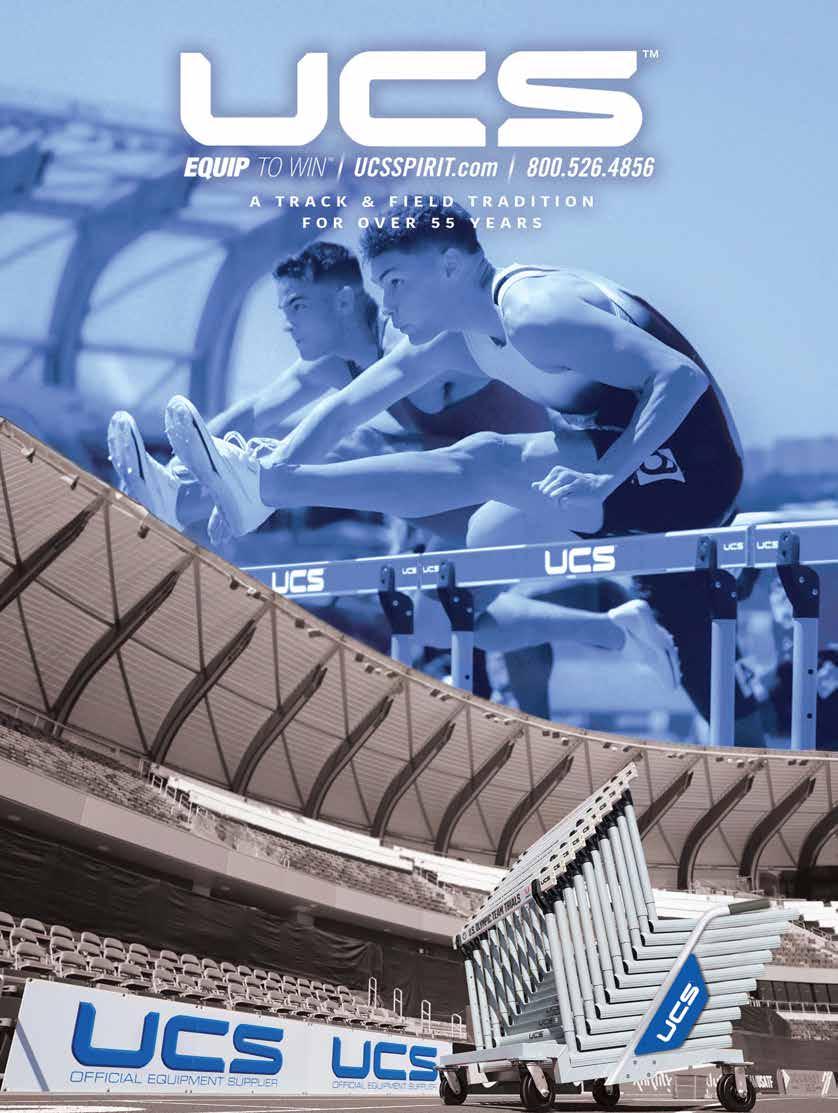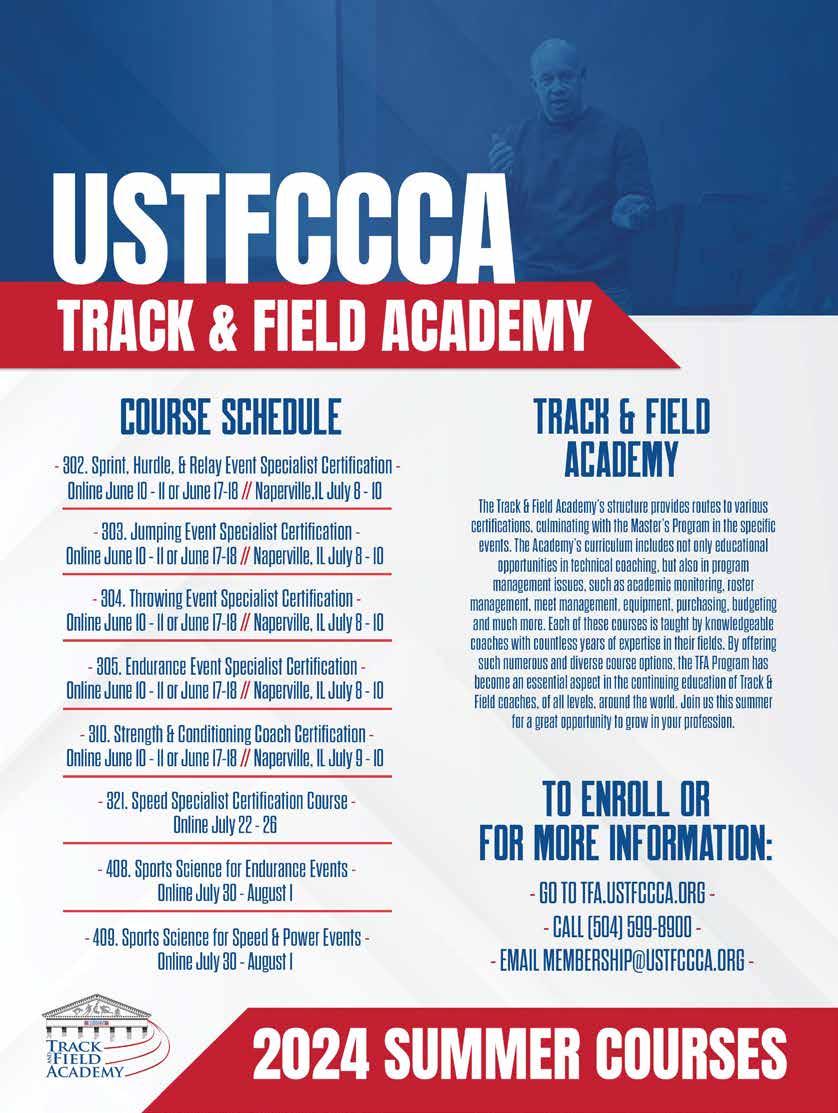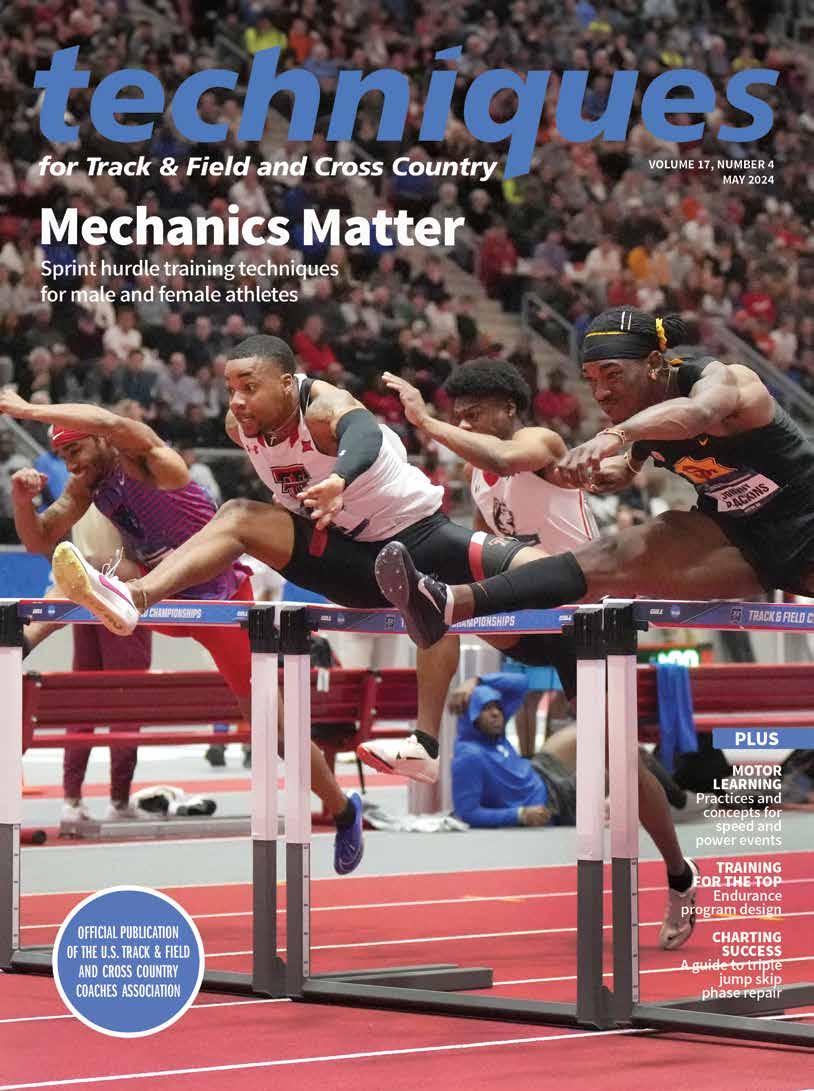

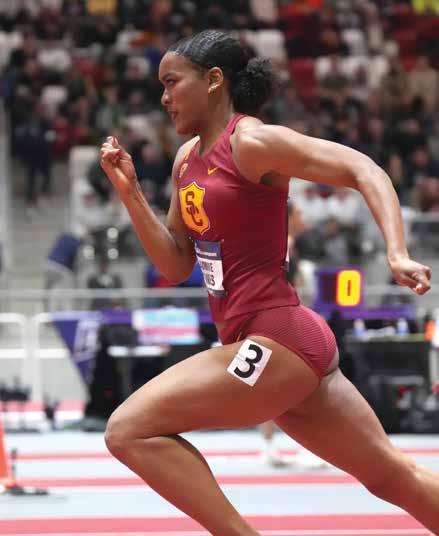

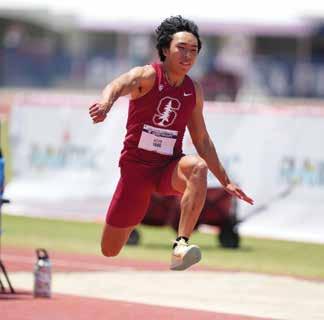
MAY 2024 techniques 1 IN EVERY ISSUE 6 USTFCCCA Presidents AWARDS 46 2024 National Indoor Track & Field Athletes and Coaches of the Year FEATURES 8 Aiming High Differences in training men’s and women’s sprint hurdlers and short sprinters BY MIKE THORSON Contents Volume 17 Number 3 / May 2024 ON THE COVER: MAR 9, 2024; BOSTON, MA, USA; CALEB DEAN OF TEXAS TECH (LEFT) DEFEATS JOHNNY BRACKINS OF SOUTHERN CALIFORNIA (CENTER) AND JAQUALON SCOTT OF TEXAS A&M TO WIN THE 60M HURDLES IN 7.56 DURING THE NCAA INDOOR TRACK AND FIELD CHAMPIONSHIPS AT THE TRACK AT NEW BALANCE. BRACKINS WAS SECOND IN 7.57 AND SCOTT WAS THIRD IN 7.59. PHOTOGRAPH BY KIRBY LEE IMAGE OF SPORT 26 39 8 16 Back to Basics Motor learning in the speed and power events FROM THE SPORTS SCIENCE FOR THE SPEED AND POWER EVENTS COURSE CURRICULUM 26 Planning for Success Endurance training program design BY AL SCHMIDT AND SCOTT CHRISTENSEN 39 Roadmap to Rewards Triple jump step phase repair flow chart BY BOO SHEXNAYDER

2 techniques MAY 2024

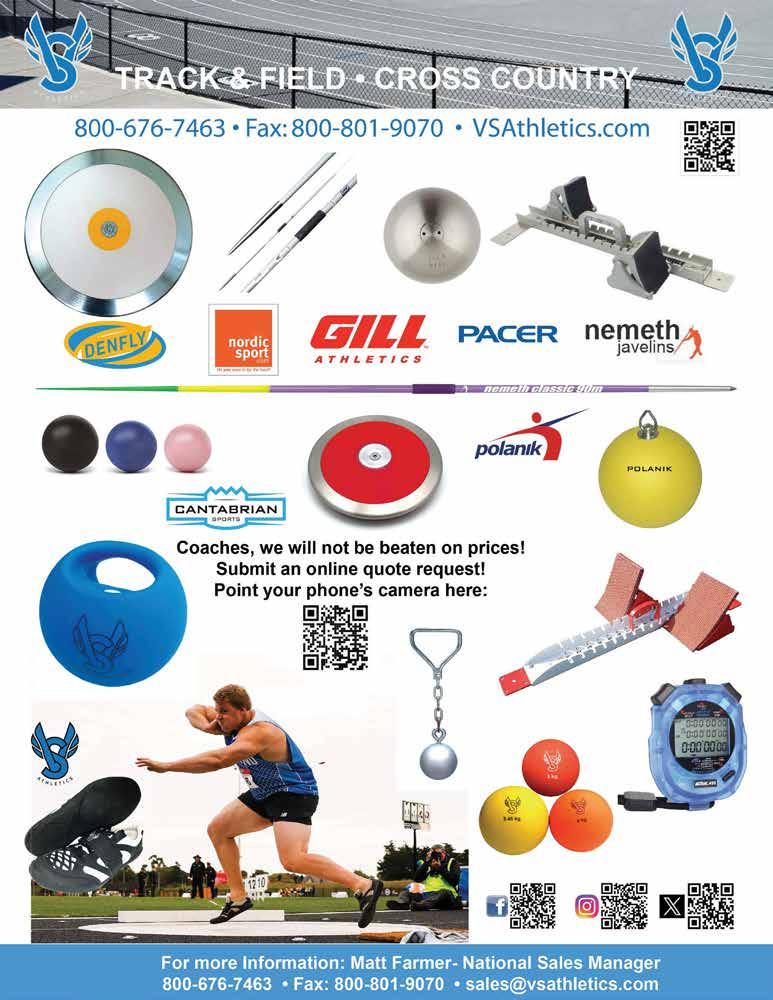
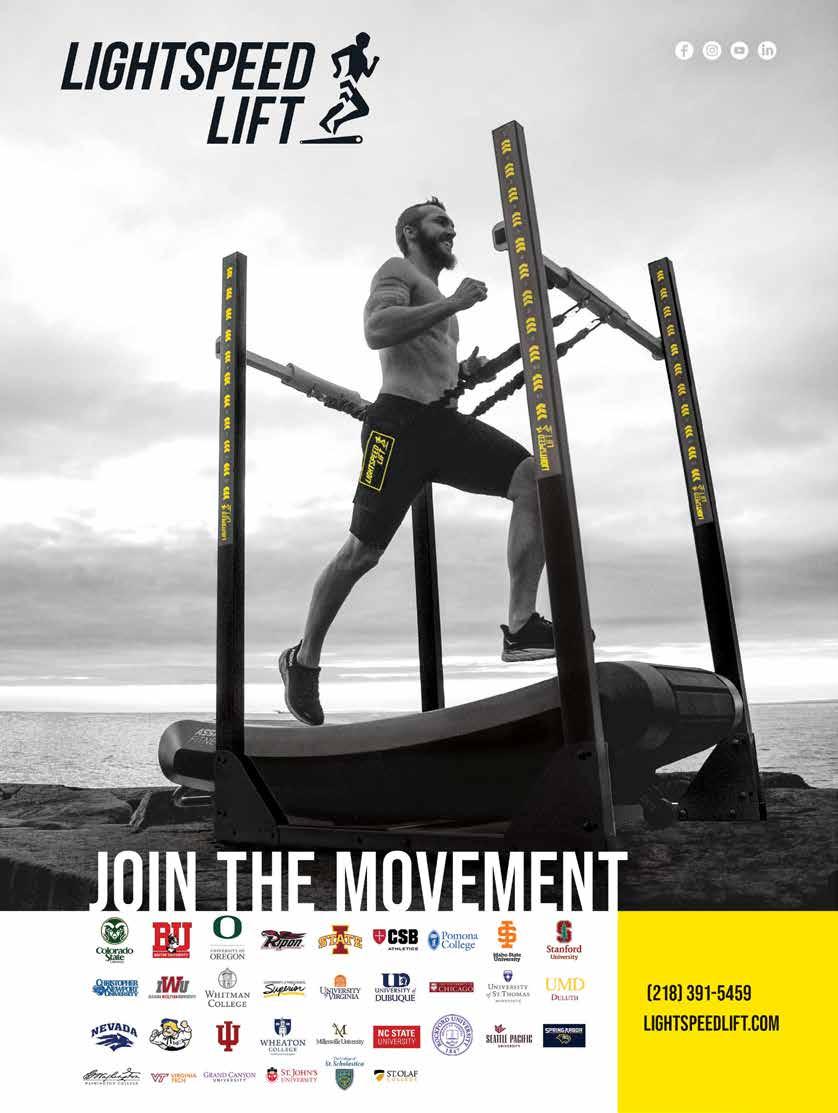
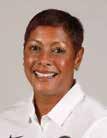
DIVISION PRESIDENTS





CARYL SMITH GILBERT
USTFCCCA President
Caryl Smith Gilbert is the Director of Men’s and Women’s Track & Field at the University of Georgia. Caryl can be reached at UGATFXC@sports.uga.edu
MARC DAVIS
Track & Field
Marc Davis is the Director of Track &Field and Cross Counry at Troy University. Marc can be reached at mddavis@troy.edu.

KEVIN SULLIVAN
Cross Country
Kevin Sullivan is the Director of Track and Field and Cross Country at the University of Michigan. Kevin can be reached at krsully@ umich.edu
PUBLISHER
Sam Seemes
Samantha Morse, Kristina Taylor, Dave Svoboda
Garrett Bampos, Tom Lewis, Tyler Mayforth, Howard Willman PHOTOGRAPHER
Kirby Lee EDITORIAL BOARD Tommy Badon, Scott Christensen, Todd Lane, Derek Yush
DANA SCHWARTING
Track & Field
Dana Schwarting is the Head Men’s and Women’s Track & Field Coach at Lewis College. Dana can be reached at schwarda@ lewisu.edu
KENNETH COX
Track & Field
Kenneth Cox is the Head Cross Country and Track & Field Coach at Birmingham-Southern College. Kenneth can be reached at kcox@bsc.edu
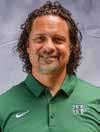

MIKE COLLINS
Track & Field
Mike Collins is the Head Men’s and Women’s Cross Country and Track & Field Coach at LewisClark State College. Mike can be reached at mcollins@lcsc.edu

CHIP GAYDEN
Track & Field
Chip Gayden is the Head
Men’s and Women’s Track & Field Coach at Meridian Community College. He can be reached at hgayden@meridiancc.edu

JAMEY HARRIS
Cross Country
Jamey Harris is the Head
Men’ and Women’s Track & Field Coach at CAL Poly Humboldt University. Jamey can be reached at jamey@humboldt.edu
MATTHEW BARREAU
Cross Country
Matthew Barreau is the Head
Men’s and Women’s Cross Country Coach at Lewis and Clark College. Matthew can be reached at barreau@lclark.edu
RYAN SOMMERS
Cross Country
Ryan Sommers is the Head
Men’s and Women’s Cross Country Coach at Bethel (Ind.). Ryan can be reached at ryan.sommers@bethelcollege.edu
DEE BROWN
Cross Country
Dee Brown is the Director of Track and Field and Cross Country at Iowa Central CC.
Dee can be reached at brown_dee@iowacentral.edu
6 techniques MAY 2024
MEMBERSHIP SERVICES
COMMUNICATIONS
ART DIRECTOR
PUBLISHED BY Renaissance Publishing LLC 110 Veterans Memorial Blvd., Suite 123, Metairie, LA 70005 (504) 828-1380 myneworleans.com USTFCCCA National Office 1100 Poydras Street, Suite 1750 New Orleans, LA 70163 Phone: 504-599-8900 Website: ustfccca.org If you would like to submit content for, or advertise your business in Techniques, please contact 504-599-8906 or techniques@ustfccca.org. Techniques (ISSN 1939-3849) is published quarterly in February, May, August and November by the U.S. Track & Field and Cross Country Coaches Association. Copyright 2024. All rights reserved. No part of this publication may be reproduced in any manner, in whole or in part, without the permission of the publisher. techniques is not responsible for unsolicited manuscripts, photos and artwork even if accompanied by a self-addressed stamped envelope. The opinions expressed in techniques are those of the authors and do not necessarily reflect the view of the magazines’ managers or owners. Periodical Postage Paid at New Orleans La and Additional Entry Offices. POSTMASTER: Send address changes to: USTFCCCA, PO Box 55969, Metairie, LA 70055-5969.
Tiffani Reding Amedeo
NCAA DIVISION I USTFCCCA PRESIDENT NCAA DIVISION II NCAA DIVISION III NAIA NJCAA

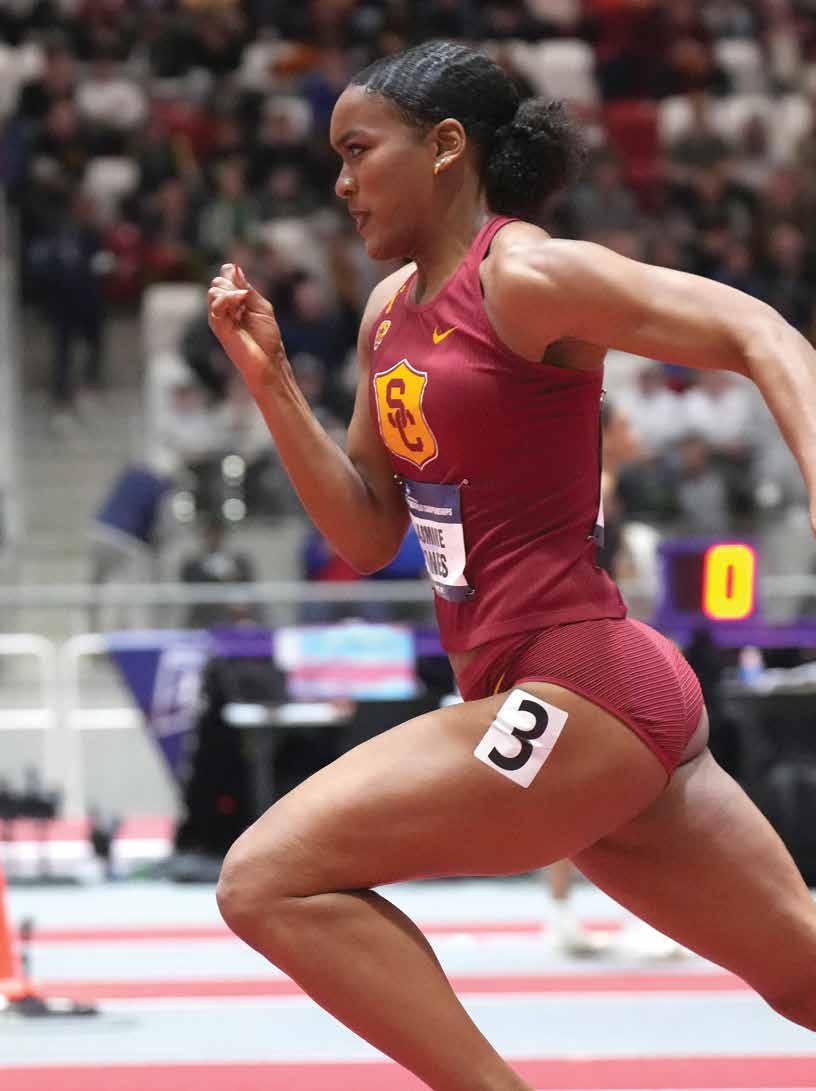
8 techniques MAY 2024

Aiming High
The differences in training men’s and women’s sprint hurdlers and short sprinters
Iwas working at the lake cabin one morning lamenting the end of both the high school and collegiate track and field seasons when I received a text from Reece Vega, a leading sprint/ hurdle coach from North Dakota State University. Coach Vega wanted to talk about the differences in training between male and female sprint hurdlers and short sprinters. I texted back that I would give it some thought, and we could talk the following day. I told him that it would be a short conversation because I trained both groups the same. The conversation, however, wasn’t short, which is very typical of the training talks between Coach Vega and me. Not short at all. It was lengthy because after really not taking the time to ponder the topic at any length, I quickly realized that I trained men and women quite differently even though they trained and competed in the same disciplines. Vega, who was an assistant coach at the University of Mary in Bismarck, North Dakota, prior to moving to NDSU, is very well acquainted with my training philosophy, and he knew that I trained the two sexes differently. Like usual, he was excited to exchange and share numerous ideas and thoughts on training like we do on a regular basis. The sharing and networking of ideas concerning training is essential for coaches. I am incredibly grateful that coaches like Loren Seagrave, Gary Winckler, Dan Pfaff, Brent McFarlane, Tom Tellez, and Jim Bush were all willing to spend time and pass on information to me as a young coach who knew very little. Seagrave, Pfaff, Tellez and Winckler were all kind enough to do clinics over the years at the University of Mary. There is no substitute for soaking up knowledge from the masters of our trade. I am always reminded of the quote by the American journalist Margaret Fuller when I think of
sharing knowledge: “If you have knowledge, let others light their candles in it.” An excellent way to put it!
The objective of this article is to present some of the major training differences between men’s and women’s sprint hurdlers and short sprinters based on what I, and really, we (I always detest the word ‘I’ in athletics) employed at the University of Mary. Our training was nothing complex or profound. Our training was a process that worked for many, many athletes and it produced successful results over a long period of time. That, in my mind, is a hallmark of a great program.
We will offer our perspective on these two topics in addition to including the ideas and thoughts from a number of leading collegiate coaches. The first area that will be discussed is the differences in training between the men’s 110-meter hurdles and the women’s 100-meter hurdles. My findings are based on 46 years of coaching experience at both the high school and collegiate levels. Most of my college career was spent at the University of Mary where I was the Director of Track and Field and Cross Country. I had prior coaching experience at the University of North Dakota (Grand Forks, ND) and North Dakota State University (Fargo, ND). The 24 years at Mary produced 46 conference championships, 406 All Americans and 38 national champions.
There are always outliers and exceptions in everything, but we should note that we based our findings and conclusions on the elite athletes that we had the privilege of coaching in our program. Some of the differences that we discuss are very significant, especially in the hurdles. Some obviously are much less dramatic and much more subtle. There obviously was some overlap and commonalities because of the similarities in
MAY 2024 techniques 9
KIRBY LEE IMAGE OF SPORT
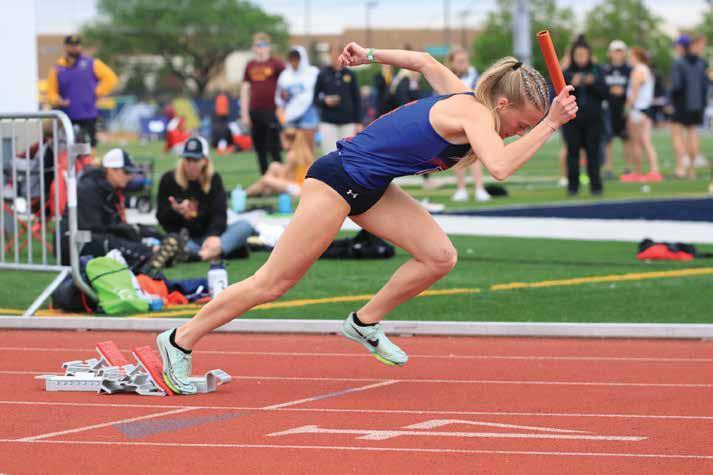
the events.
We will also look at a secondary topic in this article that is intricately connected to track training when we explore strength training differences between men’s and women’s hurdle/sprint groups.
The first topic we will tackle is the training differences between men’s and women’s sprint hurdles. The significant differences include:
More drill work is required in the men’s hurdles due to the technical demands of the event, mainly due to the 42-inch hurdle. The men must maintain a significantly higher center of gravity, as well as carrying the trail leg much higher, right under the arm, to clear the barrier. The positions and movements required to accomplish this require much more drill work and technique than the women. The late hurdle guru, Brent McFarlane, the Canadian head coach at the 2000 Sydney Olympics, would always say, “An athlete is only as fast as their technique will allow.” While drills are critically important to reach the correct technical model, they can very easily
be overdone, which many hurdle coaches are wrought to do. We have always said, “Do the drills that are needed and that will translate to being a faster hurdler. Get rid of the fatigue-producing, needless drills.” Eric Hanenberger, the associate head track and field coach at South Dakota State University, noted that in his program, “The men place much more of an emphasis on technique and lower intensity drills than the women.” This is often the case within most men’s hurdle programs. Elisha Brewer, an assistant coach at the University of Pittsburgh, said they often disregard gender, but separate groups on the days when they are doing technical work over hurdles. “We basically do the same exact training,” said the 22-year coaching veteran, who was a long-time assistant coach at Kansas where she coached world class hurdler Cordell Tinch, “but we like to separate to be able to give enough detail to the technical side of training.”
Male hurdlers do considerably less volume and require more recovery due to the energy demands of the 110-meter hurdles,
specifically again due to the height of the hurdle. I have always used one minute of recovery per hurdle as a rule of thumb, but have often had to increase that for men, especially if the hurdle repetition was over five or more hurdles. It is particularly important to keep fully accurate hurdle counts per session as the volume can add up very quickly if not closely monitored. Men also frequently needed more recovery time between hurdle training sessions. One day of recovery was often not adequate. Our survey of coaches overwhelmingly agreed that men’s hurdlers do less volume. When asked who can handle more volume, Coach Vega, one of the top hurdle coaches in the Midwest, had a very quick answer: “Women without a doubt.”
We did more speed endurance work with our men than the women, again considering the demands of the men’s race and the fact that the energy requirements for the sprint hurdles are remarkably like the 200 meters. More emphasis for women was on absolute speed, with the much lower hurdle demanding more of the speed component.
10 techniques MAY 2024 AIMING HIGH
KIRBY LEE IMAGE OF SPORT

“The low height of the hurdle makes the women’s hurdles a sprint event and they should be trained as so,” acknowledged Vega, who said his men’s hurdlers always need more speed endurance and rhythm training.
We did a great deal more hurdle repetitions with the men at the standard hurdle height of 42 inches. It was imperative that the men gain confidence and become comfortable at the regular height, opposed to the women who hurdled with 30-inch hurdles or lower 85-90 percent of the time in training. For many men entering the collegiate scene, it is a lengthy process beginning in fall training to adjust to the 42-inch hurdle.
A great deal more of the men’s hurdles training was done at standard spacing (9.14m) to train the motor pattern/rhythm that would be used in competition. Race management is much more of an issue for the men, who can utilize only approximately 75 percent of their speed in a hurdle race. The strides between hurdles are often compared to a shuffle or gallop because men simply cannot employ all their available speed due to the “crowded” spacing. Men are often forced to “chop” the hurdles, especially with a wind at their back. Our women always used discounted spacing and hurdle heights, with the spacing typically used in training being 8.0 meters. Standard for women is 8.5 meters. We varied from 7.7 to 8.3 meters. The objective in our hurdle sessions was to manipulate the spacing and hurdle heights to obtain the competition hurdle rhythms and speeds. Not that we didn’t discount spacing for men. A lot of the hurdling was done at 29 feet or 8.84 meters, or even at 28 feet (8.53m), again with the hope of mimicking the stride pattern that would be used in a race. And depending on the ability of the athlete. One of the methods of aiding in obtaining race speeds in the hurdle repetitions from blocks was “competition” in the sessions. We did very little “solo” hurdling and the competition in training was a huge benefit in allowing the athletes to reach race speeds. We were very adamant that our training would transfer to competition. One of our fundamental principles was that athletes should train to the specifics of performance. The overall goal of 95 percent or more of our hurdle training sessions, especially after the first two months of fall training, was to obtain as many competi-
tion repetitions as possible. A facet that was very critical to this aspect of hurdle training: Assuring that the recovery time was adequate between training sessions so hurdlers could be fatigue-free and in an environment where race speeds could be obtained. Chris Parno from Mankato State (MN), one of the leading collegiate hurdle coaches in the country, agreed with our principle of competition speeds in training: “The goal regardless of gender is to manage the step pattern the quickest,” said the associate head coach and four-time national assistant coach of the year. “We are always trying to teach the hurdler newer and quicker rhythmical patterns between the hurdles.”
The women did more work to the first hurdle than the men, especially emphasizing the first three steps. Typically, females needed more work in that area because of lower strength levels and how important it was to establish the proper approach and take off. We have always said that a proper, consistent takeoff is the most important part of hurdling. We never did negotiate or shorten the first hurdle markings for men or women like many coaches do. Not that we feel this is wrong. There can be great value in it. But we wanted to firmly establish the correct pattern and obtain as many true repetitions as possible over the first barrier on the standard spacing (13.72m for men, 13.0m for women).
More time was spent with the women on the psyche of hurdling and creating confidence in the race. It was imperative mentally for the women to have positive training experiences to develop the confidence needed to perform at their highest levels. That is really the role of the coach for both men and women: “Illuminate the roadway to success by creating positive, confidence building experiences in training.
The second topic we will address is the training differences between men’s and women’s short sprinters. We did train men and women differently at the University of Mary and the major differences will be outlined here:
Our program attempted to consider the physiological differences between men and women. Example: Females, who possess more Type 1 slow twitch fibers, were capable of higher training volumes. Males, whose makeup included more Type 2 fast twitch muscle fibers, could sustain higher training intensities, and we constructed our
training on that perspective. We adhered to a sprint training philosophy that was based on high intensity, low to medium volume, and high recovery. Consequently, we often had to adjust the women’s intensity and men’s load volumes. Our men typically, too, needed longer recoveries than the women. Cale Korbelik, head men’s and women’s track and field coach at the University of Mary, discovered that to be true very early in his career. “I found out very quickly that men responded to speed and maximum velocity much better than the women,” he said. “ We could emphasize more volume for women and they responded very well,” according to the third year head coach. Regarding volume, Hanenberger, whose primary areas at South Dakota State are the sprints and hurdles, agreed that men “typically do less volume than women.” Jim Vahrenkamp, the head track and field coach at University of North Dakota, had a somewhat different perspective on workloads. He doesn’t necessarily set different volumes for men and women, but noted, “We set a range for the athlete they can express quality in.” Associate head coach Kebba Tolbert from Harvard also approached this in a similar manner. “In sprinting and hurdling, I find that mechanics matter and that a good consideration of event specific training density demands are fairly similar across speed, strength, power and work capacity. The differences you see are more in the ability to express power in relation to body weight and how long athletes can sustain that power,” said the highly successful coach who is a frequent clinician.
More focus was placed on front side mechanics for the women. Again, generally due to strength levels, a higher percentage of time was spent on this critical area. The women were much more prone to reverting to back side mechanics or never actually getting into front side mechanics. “Mechanics matter,” was a frequent reminder to our athletes. Athletes should always be reminded that mechanics and technique lead to more effective ground application. Front side mechanics are the movements that take place in front of the body, and according to Dr. Ralph Mann, a former professional 400 meter hurdler and renowned authority in biomechanics, “The key to producing elite sprint performance is maximizing front side mechanics and minimizing back side mechanics.” He added,
12 techniques MAY 2024
AIMING HIGH

“that the most critical component of sprint mechanics lies in the movement of the upper leg management, which demands both strength and proper movement.”
Flexibility and mobility were much more of a priority for the men than women. Many of the men did not have the flexibility or mobility to allow them the range of motion needed to obtain the proper mechanics to create the needed forces in successful sprinting. We were fortunate that our strength department did an excellent job with flexibility, mobility and core training.
Relaxation was another area where men spent a greater amount of time. It is not uncommon to see men “muscle the race,” especially in the 100 meters. We quite often said that getting sprinters to complete a nice, smooth, and relaxed race was one of the most difficult pieces of the puzzle to teach.
More attention to block work, starting mechanics, explosiveness and acceleration was a greater focus for our women opposed to the men. More activities and exercises to build explosive power and strength - all foundational ingredients in acceleration and block work - were needed for the women.
PHYSIOLOGICAL DIFFERENCES
It was remarkably interesting that none of the coaches responding to the survey touched on the physiological differences between men and women, the female menstruation cycle or oral contraceptives for females in either their track training or in the strength programs. Some of those areas were strictly off limits years ago, especially in a male-dominated profession. But one would hope we have moved past that era. One coach, however, when asked about the subject, acknowledging that it would certainly benefit training for his athletes and especially for the females, said he wouldn’t think of delving into this sensitive area because it would be a human resources nightmare.
The research, however, tells us this is an area that can dramatically affect injuries and performance. It also tells us that as coaches we are doing our athletes a disservice if we don’t take the differences into consideration. An example of what we are talking about here is quote from Jason Karp, a noted coach, exercise physiologist and bestselling author, who summed this up best when he said, “Understanding the menstrual cycle is the key to unlocking the
female runner’s training secret.”
We certainly didn’t have a systematic plan in place for dealing with these differences at Mary, but we often made modifications and changes in the training schedules to accommodate these issues. I certainly have no data to support my suspicions, but looking back, many of our injuries and subpar performances were likely the result of not making the necessary training modifications, changes, and not taking into consideration the physiological differences between men and women with a consistent, methodical plan.
STRENGTH TRAINING
Unlike the training differences topics, both coaches and athletes were surveyed and asked questions pertaining to their strength training programs. It was extremely interesting that both groups said that their men’s and women’s strength programs were essentially the same at their respective institutions. Many of the athletes (both current and former) said it wouldn’t necessarily have helped to have separate training programs for the different genders. There were, however, athletes that didn’t go along with that line

14 techniques MAY 2024
AIMING HIGH
of thought.
“We always had the same strength training programs as the men,” noted Danylle Kurywchak, a collegiate All American triple jumper who trained at the Olympic Training Center and was the jump coach at the IMG Academy in Sarasota, Florida at one time. “It would have been better to have event specific lifting programs,” she added. Kurywchak also thought the physiological differences between men and women should have been considered. “There is a very under studied idea that women should be training and lifting differently throughout the different phases of their menstrual cycle.”
Josh Lamers, who started his career at LSU and who was an All American hurdler at the University of Mary, shared some of the same thoughts as Kurywchak on the physiological differences. Lamers, a chiropractor who has done research in this area, cited a number of different factors concerning the changes that he felt should be taken into consideration and routinely aren’t. One he noted was the differences in muscle fibers. “Females have a proportionate amount of Type 1 muscle fibers which lends itself to faster recovery rates. Men have more Type 2 muscle fibers and need more recovery time. A good strength training program should reflect that,” he emphasized. Lamers also pointed to men having higher levels of testosterone, aiding in growing more muscle mass more quickly. “This obviously will impact the overall periodization of the strength programs,” he concluded.
Another former athlete who is now a sprint/hurdle coach at Bismarck Junior College (ND), Julia Hammerschmidt, a German athlete who was an All American collegiate hurdler, feels the programs should be more individualized and cater to the needs of the different athletes. “I feel the strength programs should be more track specific and utilize lifts that actually transfer to the explosive movements needed on the track. “
Many of the coaches in our study communicated that they had basically the same strength programs for men and women, but that in most cases it was individualized to a degree. The coaches who were the least pleased with their lifting programs were the ones who did not have control of the programming and relied heavily on strength coaches. “I do individualize the programs as needed, ”said Coach Tolbert, who has been at Harvard for 12 years. “Certain athletes may get
more volume in the various activities or more intensity. But this is applied across all my training cycles, whether it be strength, speed, or power activities.”
Coach Vahrenkamp, who is in his third year of guiding the University of North Dakota program, reflected the same thoughts as Coach Tolbert. “Strength training protocols for men and women are predicated on achieving performance norms provided in the USTFCCCA coaching curriculum and derived from high performance norms in elite level athletes. Each athlete is at a different point on that continuum and travels toward those goals at different rates. There are various considerations and adaptations that we make that are typically based on different motor patterns, training age and physical architecture that we prescribe. The opportunity for variation in the weight room is excellent. Ultimately, the goal is to develop speed power qualities to a level that support the demands placed on speed and power athletes on the track.”
Coach Hanenberger, who came to South Dakota State University in 2015, expressed some of the same thoughts as Vahrenkamp. “Our strength programs are similar, but really more dependent on training age than gender,” he remarked. Coach Vega stated that their strength programs were individualized to a point. “We look to train movement and qualities that all athletes will benefit from. But women will usually handle more repetitions and volume with less perceived stress.”
We reached out to our former strength and conditioning coach at Mary to gain his thoughts on the differences between males and females in the weight room. “ I would hope that the differences between the two sexes are being considered,” said Mike Silbernagel, a former strength and conditioning coach at Mary and Colorado State, who is now directing a sports performance center. “From my experience, females could handle and needed higher intensities closer to peaking, where males needed more of a true deload to peak,” said the longtime coach. “There are a number of other factors, but that would be a major one.”
Colton Razo, an assistant strength and conditioning coach at Ohio State, had some thoughts on this theme as well. “I don’t deal in absolutes, but on the average, I keep volumes and frequency of dosages higher with women than men,” commented the Buckeyes coach. “But I have had men I treat more like women, and women I treat more like men, and
there is a large bandwidth in between. I like to close them with an intense session 10-14 days out from a major competition. But even within those intense sessions, they can look very different. My longer, more facially driven athletes will usually be more on the plyometric/ballistic side. The stockier, muscle driven power athlete will be higher force/RFD based,” he concluded.
SUMMARY
Many of the coaches were much like me when they first outlined their training programs in that they felt they trained their men’s and women’s short sprinters and sprint hurdlers very much alike. But after talking to the various coaches and studying their survey responses, examining their training, thoughts, and comments, it was very apparent that this wasn’t truly the case. At least in most instances. The reality was that they were training men and women differently. And they should be. The facts and research tell us this very loudly. It is inexcusable not to be. The old “one size fits all” training programs that coaches pulled out of their desk drawers are far outdated. They have no place in training methodologies or in the weight room. The great coaches and the great programs customize and individualize their training programs to meet the demands and needs of individual and physiological differences in their athletes. It isn’t even really a question. It is essential if a coach desires to have repeatable, consistent, and successful results with their athletes and programs.
REFERENCES
Karp, Jason, article in Track Coach from his book, Running Periodization: Training to Run Faster
Mann, Ralph, The Mechanics of Sprinting and Hurdling, 2018 Edition
**A special thanks to Ann Thorson and Amelia Maher/Sherman for their editing and technical assistance.
MIKE THORSON, FORMER DIRECTOR OF TRACK & FIELD/CROSS COUNTRY AT THE UNIVERSITY OF MARY (BISMARCK ND)
MAY 2024 techniques 15
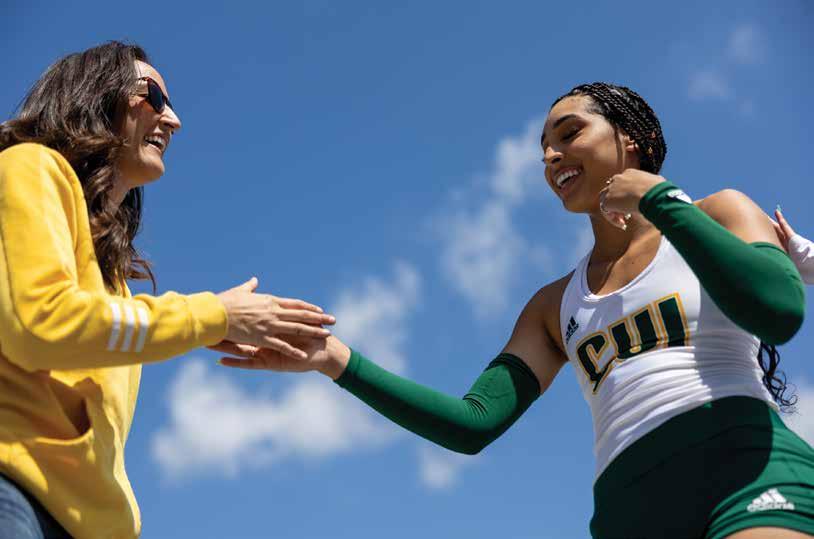
Back to Basics
Motor Learning in the Speed and Power Events
Motor learning is a field of sports science that investigates the processes and factors involved in learning skills. In this section we will investigate motor skills, motor control and how we can use this science to improve the effectiveness of our skill teaching schemes.
Movement Strategies. Many factors come into play when one attempts to perform even the simplest motor task. Before a movement pattern is initiated and executed, the nature of this movement is decided upon in some manner. We will call the pattern of movement planned to accomplish the task a movement strategy. We will call the process of the formation of this strategy movement organization.
Theories of Movement Organization. There are two theories governing thought
regarding the organization and formation of movement. It is likely that there is some validity to both of these theories, as neither can completely explain all observed phenomena.
The Generalized Motor Program Theory. In this view of movement organization, a learned skill exists as a motor program that can be called upon and executed anytime it is needed. The program may be adapted to various situations and environments to adapt to some changed circumstance, but the basic characteristics of the program exist regardless of the environment in which the skill is performed.
The Dynamic Systems Theory. In this view of movement organization, when a skill is performed, movement strategies are organized with respect to many environmental factors. The ability to replicate skills results
from repeatedly organizing movement in similar environmental conditions.
FACTORS AFFECTING MOVEMENT STRATEGY FORMATION
Cognitive Decision. Volitional thought processes are employed to trigger the use of some generalized motor program, or devise some original plan of action to undertake the task.
Nature of the Task. The demands of the task itself, or the results that characterize success help determine the strategy employed.
Perception of the Task. The manner perceived to be most appropriate for undertaking the task determines much of the pattern of movement. However, often the strategy that instinctively seems most appropriate is in fact a poor one. In these situations, teaching
16 techniques MAY 2024 KIRBY LEE IMAGE OF SPORT
the correct pattern of movement is doomed to failure because the learner’s perception is faulty.
Reflexive Action. Certain movements or actions may elicit reflexes, which cause other movements to occur. These may positively or negatively affect performance. Stretch reflexes and some proprioceptive concerns fit into this category. We must teach movements that elicit the correct reflexive actions.
Injury Prevention Mechanisms. Selfdefense and injury prevention reflexes may thwart complete execution of certain movement strategies, or cause the originally planned movement to be modified in some way. We must design techniques that do not evoke these reflexes. Also, as coaches we must be able to differentiate between what is a dangerous situation and unfounded fear.
Prior Motor Experience. Learners have generalized motor programs and patterns of movement already constructed and in place. The adaptability of these to the task at hand may invoke their usage in movement situations. A generalized motor program that is in place provides a convenient option when devising a movement strategy, yet this program may or may not be appropriate.
Environmental Factors. Environmental factors have some effect on the pattern of movement chosen. Environmental factors can include prior positioning of the body, prior movements of the body, perception of prior movement, and the location of related pertinent objects.
Mechanical Concerns. The laws of physics that govern production and application of force make certain strategies more efficient and appropriate. Humans may inherently sense these laws and operate accordingly, but often they must be taught movement strategies that are efficient in this regard.
Anatomical Concerns. The anatomical construction of the human body, specifically the structures responsible for the production and transmission of force affect the movement strategies we choose. We must beware, because at time a movement strategy that we deem efficient when considering the laws of pure physics may be ineffective when the anatomical structure involved is considered. Falling into this category of concern are unique aspects of muscle architecture and joint structure.
Proprioceptive Concerns. Preferred proprioceptive patterns serve to affect the perception and execution of movement. Effectiveness or patterns of proprioception may determine the muscle recruitment patterns used in the movement.
Physical Capabilities. An individual’s personal set of strengths and weaknesses in
the areas of strength, speed, coordination, flexibility, and endurance help to determine the strategies employed in performing a task. A body imbalanced in these areas, or whose body parts are imbalanced with respect to each other will likely reflect these imbalances in some way in the patterns of movement chosen.
LEARNING SKILLS
STAGES OF LEARNING
Acquisition. This consists of the earliest attempts at the skill, when the learner is basically becoming familiarized with the movements of the skill.
Refinement. This stage consists of the time spent after acquiring the ability to perform the basic movements of the skill, when efficiency and accuracy are greatly improved.
Stabilization or Diversification. This stage consists of the period of time during which the learner becomes able to replicate the skill at will easily and effectively, or becomes able to adapt the skill into other situations by modifying it to some extent.
Adaptation. The learning of a motor skill can be considered an adaptation to training. The process of skill learning is comparable to the process of producing other training adaptations with respect to process, timeframes, and progression.
THE PRACTICE ENVIRONMENT
The Purpose of Practice. The practice environment may be constructed differently depending upon the purpose of the practice. While we often think of teaching a skill, there are other purposes.
Teaching a Skill. The practice might be geared toward teaching a skill that is new or fairly new to the athlete.
Rehearsing a Skill. The practice might be geared toward rehearsing a skill that is nearly or already learned and mastered.
Correcting Faults. The practice might be geared toward correcting faults in a skill that has already been learned.
Rehearsing Communication. The practice might be geared toward rehearsing cues, cue responses, skill corrections, and meet communication.
Meet Simulation. The practice might be geared toward simulating a competition in some way.
Practice Distribution. Research shows that shorter, more frequent practice periods are more effective than less frequent, longer practice periods. This lends itself to the philosophy of integration of the physical training and technical teaching program. This is because the wide variety of activities in the physical development program offers many opportu-
nities to practice the skill or parts of the skill.
The Practice Environment and Stage of Learning. The practice environment should be appropriate to the stage of learning. The intensity of the practice situation must be low in the initial stages of learning. Also, practicing complex skills in parts is appropriate in these early stages of learning. As proficiency increases, the practice environment can become more intense and complex.
Whole vs. Part Practice. Whole practice is practice where the entire skill is performed in each trial, while part practice consists of practicing only some part of a skill with each trial. Research shows that whole practice is more effective in most learning situations. However, very complex skills, such as many of those we find in athletic events, are often too complex for the beginner. These skills should be introduced using part learning, or possibly using a whole-part whole approach. While there are actual athletic coaching situations where whole, competition specific practice may not be appropriate; we are generally better off employing larger parts of the movement.
Variety in the Practice Environment. Research shows that variety in the practice environment improves performance in test situations, even though practice performance may not be improved. This suggests that we employ a variety of teaching progressions, drills, and activities in practice. Planned changes in practice intensities and complexities should be employed to create the most effective learning environment and foster the greatest gains.
Choosing Practice Activities. The exercises and drills used in the practice setting provide a context for teaching needed skills or parts of skills. The selection of these activities must be in accordance with all the considerations above for effective learning to take place.
Intensity of Practice. Practice environments can be constructed that are of low or high intensities. This intensity is determined by the activities chosen for the practice. The intensity of practice must not only be appropriate to the stage of learning, but also to the purpose of the practice. Skill teaching requires a low intensity environment. Meet simulation dictates a high one. Communication and cue rehearsal can employ either, depending on other variables.
THE OVERLOAD PRINCIPLE
The Overload Principle. The Overload Principle states that the body must be stressed to some degree in order to produce adaptation. Normally, when we consider or discuss the Overload Principle, we are considering a training stimulus and a resultant
MAY 2024 techniques 17
increase in fitness.
The Overload Principle and Motor Learning. The Overload Principle can be applied to the learning of a skill as well. Wellplanned, progressive increases in the intensity at which the skill is performed can accelerate the learner through the stages of learning, and make learning more permanent.
Increasing Practice Intensities. Failure to increase the intensity of the practice environment can result in staleness and lack of progress, due to failure to challenge the organism. At the same time care must be taken not to increase the intensity of the practice environment too quickly, as this could result in regression.
Mastery Levels and Progression. Generally speaking, it is a good practice to increase practice intensities slightly once a certain level of mastery is gained at the previous intensity level. This level of mastery should be high, but expectations of 100% mastery before advancing are unreasonable. 100% mastery at a certain level of intensity is often attainable only after some increase in practice intensity beyond that point.
COMMUNICATION
Quality of Communication. For effective learning to take place, communication must be of high quality. All communication should be clear, precise, and have meaning to the teacher and learner.
Quantity of Communication. For effective learning to take place, the quantity of communication should be limited. A person is only able to grasp a certain amount of information at a time, and is able to use only a certain amount on each trial.
COMMUNICATION TYPES
Verbal Communication. This is communication using the spoken word. While only one of many forms of communication, it is generally the form most frequently used and misused.
Nonverbal Communication. This is communication using other means besides the spoken word. Demonstrations, signs, gestures, and even body language fall into this category.
Coach to Athlete Communication. A coach’s ability to effectively communicate ideas and concepts to a learner is a crucial skill. Good communication can take many forms, and a skilled coach should be adept at these frequently used ones.
Verbal Explanations. Verbal explanations are oral verbiage used to convey some type of concept to the learner. This concept is usually
a movement concept, or some background information a coach must relay to the learner to place a movement concept in the correct context. Verbal explanations should be clear and concise. They should also be meaningful to the learner, using terms and concepts the learner is familiar with. They should also be somewhat limited in quantity, since only a limited amount of information can be processed at any one time.
Cues and Cue Systems. Verbal directions a coach gives an athlete to elicit a certain predicted motor response are called cues. A group of related cues, used with and within a context of understood terminology, used to adjust the technical models called a cue system. Like verbal explanations, cues should be clear, concise, and use limited information. We will examine cues and cue systems in detail in a later section.
Demonstrations. A demonstration is a physical performance of a skill, done by a coach or someone else, for the learner to watch. This enables the learner to ascertain information about the motor pattern and assists in movement organization. Augmented feedback demonstrations may exhibit mistakes, correct movements, or both in a contrasting manner.
Augmented Feedback. Augmented feedback is communication directed from the coach to the learner after a trial, relaying information on the performance to assist the learner in perfecting the skill. Augmented feedback may be verbal in nature, and in these cases is often related to some cue system. Augmented feedback can also take the form of a demonstration, technological forms such as film, or any combination of the above. We will examine in detail the process of providing augmented feedback in a later section.
Athlete to Coach Communication. Communication from athlete to coach is a crucial part of the communication process and a needed part of an effective learning environment. An athlete who is skilled at communication can greatly accelerate learning and help the coach avoid many hours of misunderstanding. While a coach may not be fortunate enough to be working with an athlete who is a good communicator, it is part of the teaching process to assist the athlete to communicate information the coach needs. A coach can foster athlete to coach communication several ways.
The Coach as a Listener. The coach should, within reason, convey openness to the athlete, creating a learning environment in which the athlete is comfortable conveying
information to the coach, and is assured it is being valued and considered.
Athletes Intrinsic Feedback. Sensation athletes perceive and experience during performance, while not always accurate, can offer very important clues to a problem solving coach. The coach should create a learning environment where, within reason, this type of information is solicited and valued.
Questioning the Athlete. The coach should be skilled at asking direct, clear questions to ascertain needed information from the learner, and to assist the athlete in communication.
AUGMENTED FEEDBACK
TYPES OF FEEDBACK
Knowledge of Performance. This is augmented feedback that consists of information the learner receives concerning the correctness of incorrectness of the movement pattern itself. Most coach issued augmented feedback falls into this category, and most research shows this type to be most frequently used and most effective form of feedback. The skilled coach should be familiar with athlete’s perceptions, as these perceptions may at times conflict with the knowledge of performance feedback issued by the coach.
Knowledge of Results. This is augmented feedback that consists of information the learner receives concerning the measurement of the performance’s success. This type of feedback sometimes must be provided to the learner, but is often immediately available due to the nature of the skill.
Qualitative Feedback. Qualitative feedback is augmented feedback that has no value attached to it. Instructions are simply given or corrections made, and no effort is made to convey to the athlete the degree of change needed or the location of that particular performance on a spectrum of many.
Quantitative Feedback. Quantitative Feedback is augmented feedback that has a value associated with it. Not only is information provided as to the quality of movement, but also the degree of change performed or needed.
FEEDBACK METHODS
Demonstrations. Demonstrations occur when the coach or someone else physically performs a skill for the learner to watch. This enables the learner to ascertain information about the motor pattern and assists in movement organization. Augmented feedback demonstrations may exhibit mistakes, correct movements, or both in a contrasting manner.
18 techniques MAY 2024
BACK TO BASICS
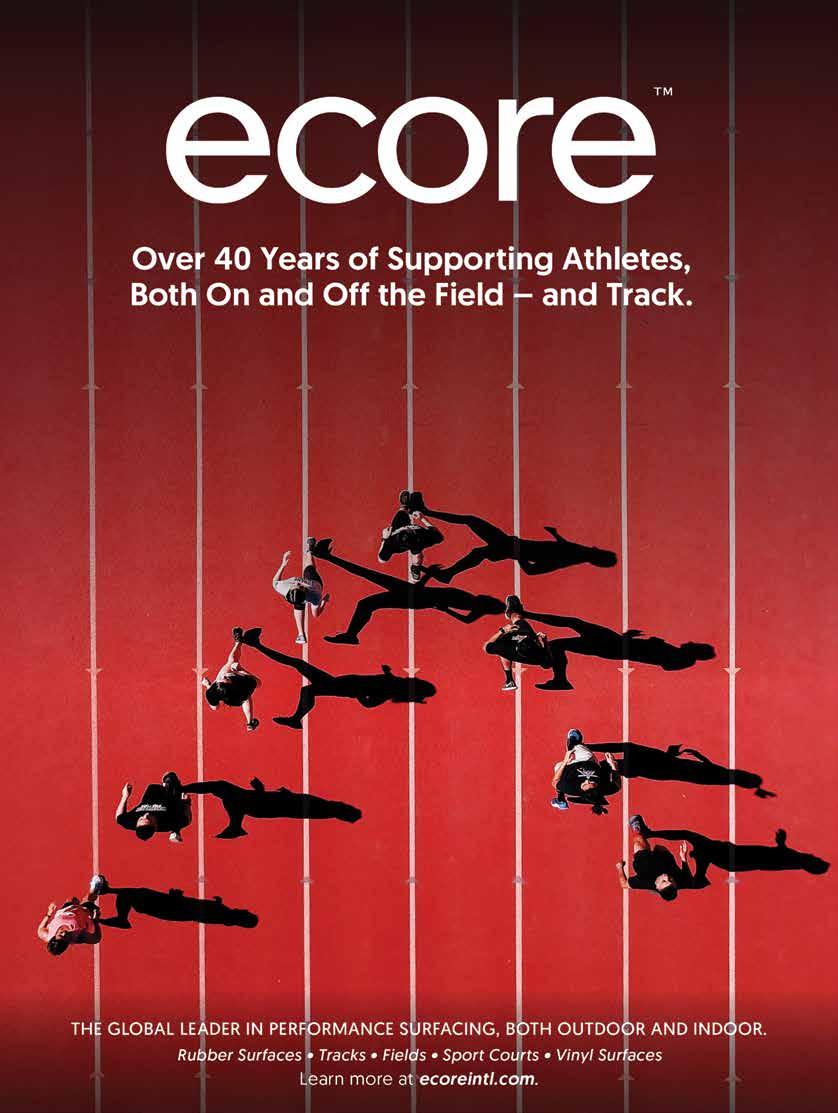
Verbiage. Verbiage consists of orally presented feedback, usually in the form of a cue or explanation.
Video. Augmented feedback can be provided via electronic media, in order to present a clear picture of the athlete’s movements or the movements of some selected model.
PROVIDING FEEDBACK
Frequency. Another key issue in providing feedback is how often feedback should be provided. Frequent feedback is helpful, especially in the earliest stages of learning. However, research shows that feedback issued after each and every trial is not effective.
Feedback Strategies. Feedback can be addictive, and feedback addiction can disrupt the athlete’s intrinsic feedback mechanisms and hinder learning. Frequency of feedback issuance can be managed using these strategies.
Fading. This is a strategy in which feedback is issued after every trial in the earliest stages of learning, but the amount of trials after which feedback is not provided is gradually increased over time.
Self-Selected. In this strategy, the learner solicits feedback from the coach when wanted.
Bandwidth. In this strategy, the coach provides no feedback as long as performance is within preset, acceptable limits. When performance falls below these standards, corrective feedback is provided.
Summary. This is a strategy in which multiple trials are performed without feedback. After this set of trials, the feedback on the entire set of trials is issued. Focus can be on characteristics of individual trials, or trends that develop over the course of the trials.
CUES AND CUE SYSTEMS
Cues. Cues are words we use to elicit responses in our athletes. Cue systems are combinations of cues we use in order to elicit various responses or levels of a response. Cues can be generally categorized into one of the four categories below. This list of categories is not necessarily complete, and the categories are not exclusive.
TYPES OF CUES
Spatial Cues. Spatial Cues are cues dealing with the location and relative position of the body parts with respect to other parts or the environment.
Temporal Cues. Temporal cues are cues that deal with the timing or the rhythm of
movements with respect to spatial landmarks or other movements.
Fragmentive Cues. Fragmentive cues are cues that deal with small portions of a larger movement.
Holistic Cues. Holistic cues are cues that deal with gross characteristics of the movement or larger portions of the movement.
Quantitative Cues. Quantitative cues refer to the amount of mastery rather than absolute right-wrong states. Telling an athlete that an improvement was made from a 50% mastery level to a 75% mastery level gives the athlete not only an indication of progress, but also an idea of how radical the change intended must be.
Radical Cues. Radical cues describe a partially learned skill as a totally new skill, as to minimize learning interference from the previous pattern of movement.
Overcuing. Overcuing occurs when an opposite error is cued, in order to produce results somewhere between the two extremes.
Periodization of Cue Systems. Cue systems, like training, should be periodized in accordance to motor learning principles. Aspects to consider include these.
Cue System Progression. Certain types of cues are more effective at certain times because of the state of training and the degree of synthesis completed in the technical teaching program. Over the course of the training period we progress from spatial and fragmentive cues to temporal and holistic cues, although there may be exceptions to this rule.
Cycling Cue Systems. Cues should also be cycled much as training is cycled. Cues, like training, are a stimulus to produce an adaptation. The adaptation desired is changed behavior. Thus, adaptation to a cue occurs over time, and the value of the cue then decreases for the time being.
TEACHING TOOLS
Drills. Drills are activities that enhance learning by placing the athlete in an environment that permits a heightened chance of success in performing a skill. It is important to note that drills provide an environment in which to teach, but do not serve to teach a skill.
Technical Exercises. Technical exercises are training activities designed to provide opportunity to teach certain fundamental skills that apply to one or more events. It is important to note that technical exercises provide an environment in which to teach, but do not serve to teach a skill.
Teaching Progressions. A teaching progression is a series of technical exer-
cises and/or drills that form a pedagogically sound sequence and system for teaching an advanced skill.
Technical Rehearsal. Technical rehearsal is the rehearsal and refinement of previously learned skills that are highly specific to the event.
INTEGRATION OF TECHNICAL TEACHING AND TRAINING
Teaching Across the Training Program. Finding opportunity to address technical features within the context of the training program is an important part of technical teaching. Many of these opportunities lie in portions of the training program one would not ordinarily classify as technical in nature. For this reason it is crucial to integrate technical training and the training of other physical performance components. Technical teaching should occur throughout the entire training program.
Utilizing Technical Sessions. Technical sessions should be reserved to teach and rehearse unique elements of the event. The remainder of the training program should be designed to provide adequate opportunity to address commonalities and fundamentals.
CUES AND CUE SYSTEMS
Cues. Cues are words we use to elicit responses in our athletes. Cue systems are combinations of cues we use in order to elicit various responses or levels of a response. Cues can be generally categorized into one of the four categories below. This list of categories is not necessarily complete, and the categories are not exclusive.
TYPES OF CUES
Spatial Cues. Spatial Cues are cues dealing with the location and relative position of the body parts with respect to other parts or the environment.
Temporal Cues. Temporal cues are cues that deal with the timing or the rhythm of movements with respect to spatial landmarks or other movements.
Fragmentive Cues. Fragmentive cues are cues that deal with small portions of a larger movement.
Holistic Cues. Holistic cues are cues that deal with gross characteristics of the movement or larger portions of the movement.
Quantitative Cues. Quantitative cues refer to the amount of mastery rather than absolute right-wrong states. Telling an athlete that an improvement was made from a 50% mastery level to a 75% mastery level gives the athlete
20 techniques MAY 2024 BACK TO BASICS


not only an indication of progress, but also an idea of how radical the change intended must be.
Radical Cues. Radical cues describe a partially learned skill as a totally new skill, as to minimize learning interference from the previous pattern of movement.
Overcuing. Overcuing occurs when an opposite error is cued, in order to produce results somewhere between the two extremes.
Periodization of Cue Systems. Cue systems, like training, should be periodized in accordance to motor learning principles.
Aspects to consider include these.
Cue System Progression. Certain types of cues are more effective at certain times because of the state of training and the degree of synthesis completed in the technical teaching program. Over the course of the training period we progress from spatial and fragmentive cues to temporal and holistic cues, although there may be exceptions to this rule.
Cycling Cue Systems. Cues should also be cycled much as training is cycled. Cues, like training, are a stimulus to produce an adaptation. The adaptation desired is changed behavior. Thus, adaptation to a cue occurs
over time, and the value of the cue then decreases for the time being.
OVERLOAD AND ADAPTATION
The Overload Principle. The Overload Principle applies to motor learning as well. For this reason, progressive, periodic increases in the intensity of the learning environment are necessary. While some level of mastery is needed before increasing intensity, intensity increases always precede progress in learning.
Adaptation. Motor learning is a form of adaptation. Like other adaptations, learning becomes relatively complete within certain timeframes. For this reason, the increases in intensity previously mentioned, as well as other changes to the training stimulus, should be scheduled on a regular basis.
PERIODIZATION OF TECHNICAL TRAINING
Technical Training Phases. When we examine the training year, technical training can be divided into four phases. These phases are described and arranged chronologically in the training program as follows.
Radical Changes. The first teaching prior-
ity should be a phase concentrating on radical technical changes, if any need be made.
Technical Exercises and Partial Movements. Next should come a phase of technical exercises and partial movements. In this phase, the primary emphasis is on drills that address fundamental skills and commonalities.
Whole Movements and Synthesis. Next should come a phase of whole movements and synthesis. As this phase progresses, practices resemble competition more and more, as whole movements are emphasized and intensities increase.
Problem Solving. Next should come a phase of problem solving, allowing time to correct any problems that may arise during synthesis.
Distribution of Phases. Much consideration should be given to how time is distributed to these phases. Following are general guidelines.
Radical Changes. The phase of radical technical changes is ordered first, since very radical changes may require much time to complete. It often occurs even before the formal start of the training year. This phase may
22 techniques MAY 2024 BACK TO BASICS
KIRBY LEE IMAGE OF SPORT
be omitted for accomplished performers.
Technical Exercises and Partial Movements. While the phase of technical exercises and partial movements is important, excessive time should not be spent here. This phase must not extend beyond the general preparation period. Partial learning should serve only as an introduction and progression to the accomplishment of whole movements. They should not be a goal unto themselves.
Whole Movements and Synthesis. Adequate synthesis must be completed prior to competition. While developmental meets may play a role in the synthesis process, failure to achieve adequate synthesis prior to competition results in regression. This phase should begin no later than the specific preparation period, and beginning the synthesis process too late is a common error. Synthesis should be considered complete prior to competition
Problem Solving. The problem solving phase is scheduled during the early to mid competitive season. This phase provides time before the important competitions, to address difficulties that tend to arise during competition.
TECHNICAL EXERCISE PROGRESSIONS
General to Specific. Over the course of the training year, we should progress from general activities to specific activities.
Part to Whole. Over the course of the training year, we should progress from part learning to whole learning. This should take as little time as possible. In some cases, especially with beginners, we may progress from whole movements to part movements, then back to whole again.
Simple to Complex. Over the course of the training year, we should progress from simple activities to complex activities. Increasing velocities contributes to increasing complexity.
Technical Training Density. The density of technical practice is another factor to consider. This depends upon many variables, including training age and experience of the athlete, proficiency of the athlete, and number of events done. Young athletes should have a higher density to technical sessions in their training, while older, more experienced athletes may devote only one or two days a week to technical rehearsal.
PLANNING THE PRACTICE
Practice Purpose and Practice Environment. When building the practice environment, consideration should be given to the purpose of that practice. For example, slow speeds, controlled movements, and much repetition would be used to teach a skill, while high
speeds and few repetitions would be used to simulate competition.
Types of Practice Environment. Most practice environments can be classified in one of two groups. Some environments however, may exist between these two extremes. When trying to accomplish the above goals, choosing the appropriate environment often dictates success or failure.
Controlled Practices. Controlled practice environments generally feature slower speeds, reduced intensities, and higher repetitions. Typically these center about technical exercises and lower intensity technical work.
Specific Practices. Specific practice environments generally feature high speeds, meet like situations, and lower repetitions. Typically these center on skill rehearsal at intensities that resemble those of competition.
Variance in Technical Training. As in training, planned variance in the practice environment is important. Motor learning research shows that varying the practice environment, while mpossibly detrimental to the quality of practice, improves transfer to competition situations. This variance can take several forms, including these.
Changing Activities. The coach may vary the drills or technical exercises used in the session.
Changing Intensities. The coach may change intensity related variables (such as approach run length, hurdle spacings, implement weight, crossbar height).
Subtle Activity Changes. The coach may use activities that resemble the event, but are slightly different in some way.
Changing the Practice Environment. The coach may alternate between controlled and specific practice environments.
Periodization of Intensity Related Variables. The coach should develop a sound plan for periodizing all variables that have a direct bearing on the intensity or perceived intensity of a technical training session. These factors might include implement weight, crossbar height, approach run distance, or hurdle height and spacing.
Choosing Technical Exercises. Choosing the technical exercises to be used in a session is another concern. These factors come into play when making these decisions.
Whole or Part. The appropriateness of part or whole learning at that point in the training year might determine exercise choice(s).
Physical Demands. The physical demands of the exercise with relation to the athlete’s condition and point in the training year might determine exercise choice(s).
Variance. The need to include variance in the practice environment might determine
exercise choice(s).
Emphasizing Technical Features. The need to emphasize technical features, coupled with an athlete’s strong and weak technical points might determine exercise choice(s).
TYPICAL PROBLEMS
Failure to Progress in the Early Stages of Learning. Failure to progress in the early stages of learning is often due to a poorly constructed practice atmosphere. Usually the skill is too complex for the learner, and teaching should involve a more remedial approach.
Practice Regression. Regression in practice performance usually results when the demands of practice (intensity or complexity) are increased too quickly. Another cause can be failure to increase these variables, failing to provide challenge in the practice environment.
Competition Regression. Competition regression usually occurs when new learned motor patterns are not stable enough to withstand the pressures of competition. More rehearsal and/or adequate meet simulation are needed in this case.
The Choking Phenomenon. Choking in competition is not a purely psychological response. Pressures of competition and the resulting psychological strain on the performer is the root of the problem, but this strain results in some particular breakdown in motor performance. Eliminating the choking phenomenon requires identifying the technical flaw associated with it, and helping the athlete to develop an understanding of and technical solution for the problem.
REFERENCES AND SUGGESTED
READING LIST
Bompa, Tudor. The Theory and Methodology of Training (Third Edition). Kendall Hunt, Dubuque, 1993.
Harre, Dietrich, Editor. Principles of Sports Training. Sportverlag, Berlin, 1982.
Leiber, Richard L. Skeletal Muscle: Structure and Function. Williams and Wilkins, Baltimore, 1992.
Magill, Richard. Motor Learning: Concepts and Applications. McGraw Hill, Columbus, OH, 2001.
Myers, Thomas W. Anatomy Trains. Churchill Livingstone, New York, 2001.
Schmolinsky, Gerhardt, Editor. Track and Field. Sports Book Publishers, Toronto, 1993
MAY 2024 techniques 23
FROM THE SPORTS SCIENCE FOR THE SPEED AND POWER EVENTS COURSE CURRICULUM
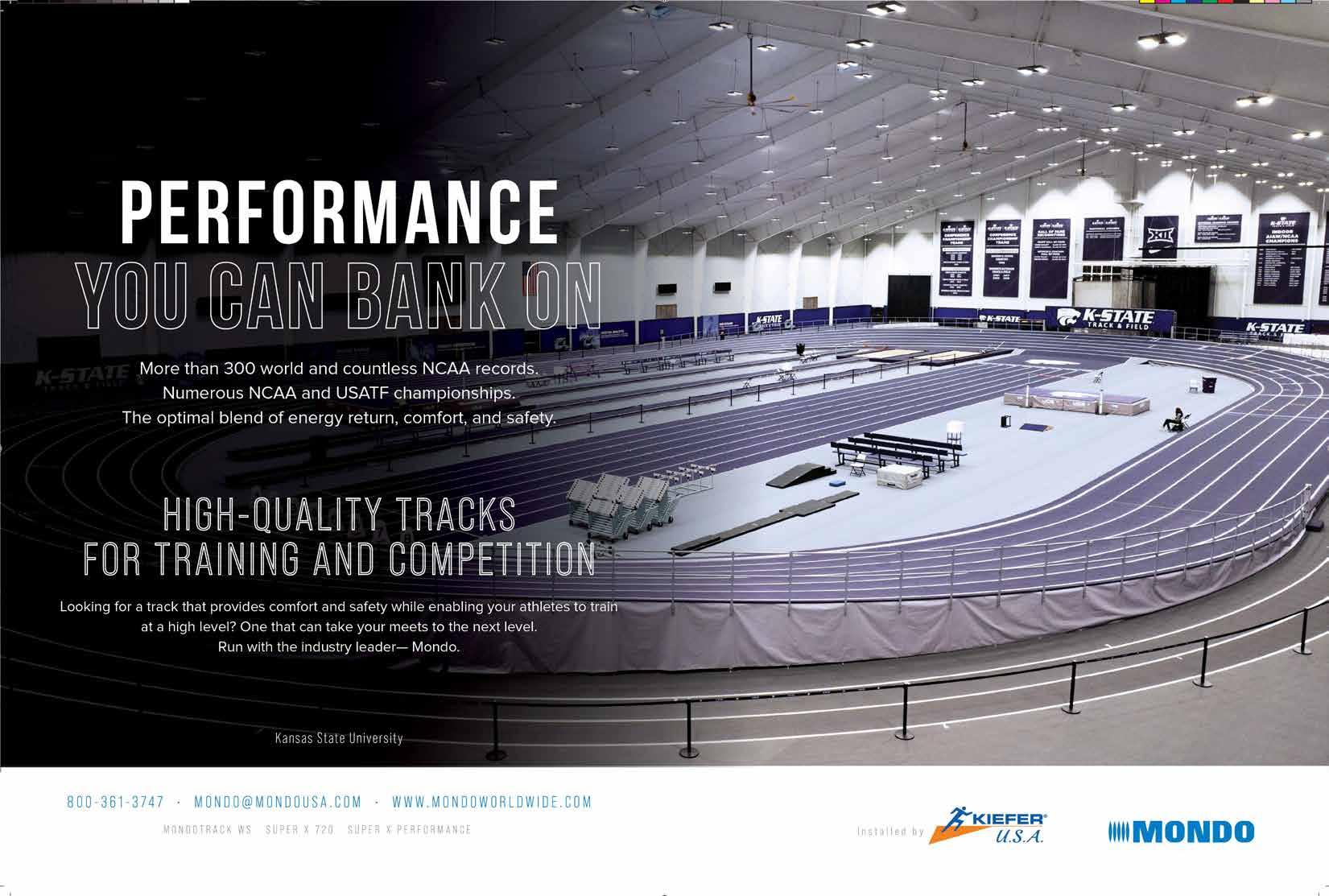

KIRBY LEE IMAGE OF SPORT
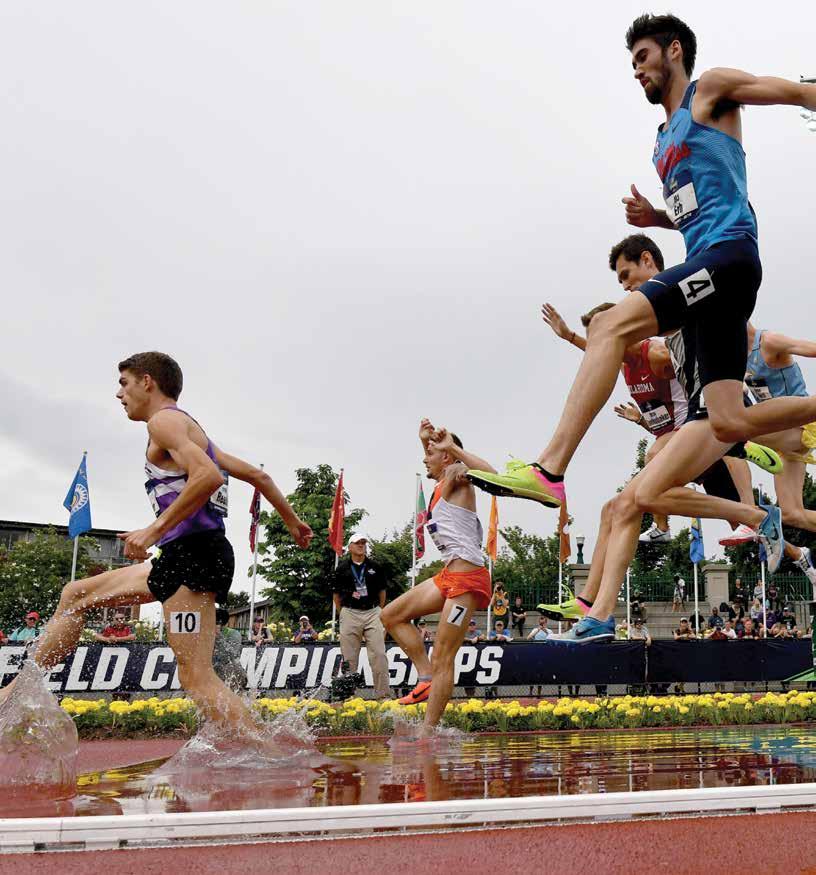
Planning for Success
Endurance training program design
26 techniques MAY 2024
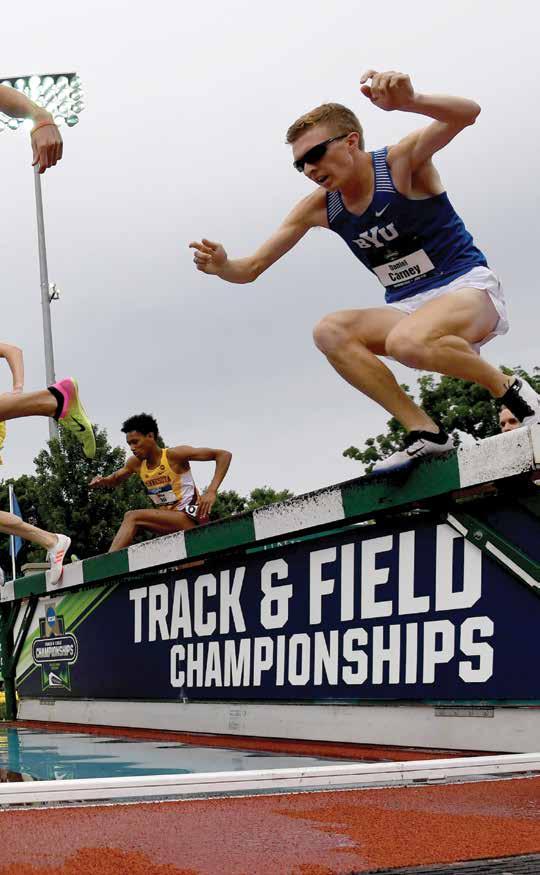
In this chapter taken from the Endurance Specialist Certification course curriculum, the general concepts that guide the designing of an endurance training program are outlined. Topics include periodization of training and the terms used to describe the various components of training.
THE PERIODIZATION AND ORGANIZATION OF ENDURANCE TRAINING
Over the past 60 years all sport training models have benefited from the scientific principles that scientists have developed to explain the natural world. The application of scientific laws and theories by coaches has transformed athletic training from a trial and error model to a systematic model of periodized development. The important link in this knowledge chain is to educate the coach to the necessary and most contemporary scientific research in a manner in which they can both understand it, as well as apply it to the athlete.
In the 1960’s and 1970’s, in a time before eastern European-influenced periodization took hold in America, the famed American endurance coach Bill Bowerman of Oregon learned his craft by trial and error testing and achieved great success. This led to the following observations on training by Bowerman:
“The principles that I thought were most important were what I have chosen to call the hard-easy. This does not mean that a person runs hard one day and takes it pretty easy the next. It depends on the individual. Perhaps a Steve Prefontaine or a Dyrol Burleson might work hard two or three days and then he might take two or three very light days.
Kenny Moore was a fragile runner and after one of his very solid workouts, it might take two or three easy days before he was ready to apply the next hard effort. Nevertheless the hard-easy principle applies and, in general, I don’t think a person can go wrong either as a coach or as an
MAY 2024 techniques 27
KIRBY LEE IMAGE OF SPORT
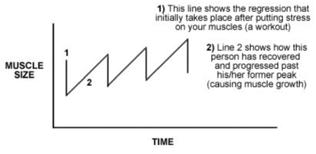
individual runner, working hard one day and taking the next relatively easy, or perhaps an effort in some other physical activity (Bowerman 1975)”.
Nowadays, in the periodization models of the various types of endurance training there requires a firm understanding of human physiological principles in the domain of contemporary scientific understanding. These models primarily differ in the distance the athlete is training for and in the biological characteristics of the individual. It is a requirement to employ a training program that matches the general and unique physiological adaptations that a specific athlete is capable of attaining in order to achieve success in the program. Ultimately, endurance training requires an understanding of the physiological principles and properly training in the aerobic energy system, anaerobic energy system, and the combined zones of each athlete. Stated simply, the “theory of periodized training” must directly relate to the theories of overload and adaptation on an individual basis (Figure 1).
Before developing a periodized training model, it is critical to look at some special considerations in constructing the yearly plan:
The total amount of time available to prepare the endurance runner for the next major series of competitions (Bourne, 2009).
The specific needs of the individual endurance runner in regard to the various primary physical performance components needed to compete at a specific event or range of events (Bourne 2009).
Any given year may require the planning of one or more macrocycles. The number will depend upon the annual structure of competitions or seasons available (or required) of a given endurance runner. Each macrocycle (a season of competition) will include a preparation phase, precompetitive phase, and a competitive phase, followed by a recovery transition phase. All
of these cycles are designed to bring about the physiological adaptations to be able to perform at a high level during the important competitions of that macrocycle.
Most countries, states and federations will employ at least two major macrocycles in a yearly endurance program. In some cases it may be necessary to include three macrocycles in a given annual program. Because of this, it is critical to be able to approach the year with a plan that will include sequential and progressive loading in order to bring about physiological adaptations that meet the demands of both or all macrocycles.
TRAINING DESIGN MODULES
In the following section, we will examine the units of training that comprise the training program, and planning considerations for each.
The Annual Plan. The Annual Plan is a plan that identifies all the available training time and provides a framework over which detailed training is planned. The annual plan illustrates the location, sequencing and duration of all phases of training, as well the themes associated with each. The annual plan should also include the competition schedule and peaking periods. A fundamental concept in the design of an annual plan is the concept of working back. This means that once the time available to train and the critical competitions which normally come at the end of the year are located on the calendar, training is planned backwards from that point.
The Macrocycle. The Macrocycle is a segment of training associated with one peaking period. Many annual plans for Track and Field consist of an indoor macrocycle and an outdoor macrocycle. Considerations regarding volume and intensity, general and specific training, and simple and complex training hold true for each individual macrocycle.
The Phase. A phase is a segment of a
macrocycle with a gross theme. Typically most macrocycles are divided into two phases, a preparation phase and a competition phase.
The Period. A period is a segment of a phase with a gross theme. In most macrocycles, the preparation phase is divided into two periods, The General Preparation Period and the Specific Preparation Period. The Competition Phase is divided into two phases, the Precompetition Period, consisting of the less important preliminary competitions, and the Competition Period, consisting of the important later competitions and the peaking period.
The Mesocycle. A mesocycle is a 4-6 week segment of training. Mesocycles are usually associated with some theme, and the sequencing of individual mesocycles should demonstrate proper sequencing of training.
The Microcycle. A Microcyle is a 7-10 day long segment of training. For planning convenience, most microcycles are one week in length. The microcycle typically has a theme, and consists of a number of training sessions sequenced in some designed order. Throughout the microcycle, to provide needed rest, recovery and variety, training emphases should alternate.
The Session. A session is defined as a single training opportunity. Each session should have a theme, and should be organized and sequenced in a logical fashion.
The Unit. A unit is a segment of a session composed of similar training activities. When units are organized into a session, they should be sequenced as follows. Keep in mind that except for the warmup and cooldown, it is not imperative that any session include all of these elements.
Always consider general principles first in the development of the endurance runner’s macrocycle. The macrocycles should be designed to bring about summative fitness changes that will ensure that the endurance runner be fully adapted to the demands of the major competitions. Race energies can be defined as the competition exercise speed at each specific aerobic and anaerobic level demanded by the particular event. This FIGURE 1. OVERLOADADAPTATION PROGRESSION
THE MACROCYCLE, PERIODS, AND PHASES
28 techniques MAY 2024
PLANNING FOR SUCCESS
1. Warmup 2. Skill and Technical Activities 3. Speed and Power Activities 4. Strength and Endurance Activities 5. Cooldown
INDICATING MUSCLE SIZE CHANGES.
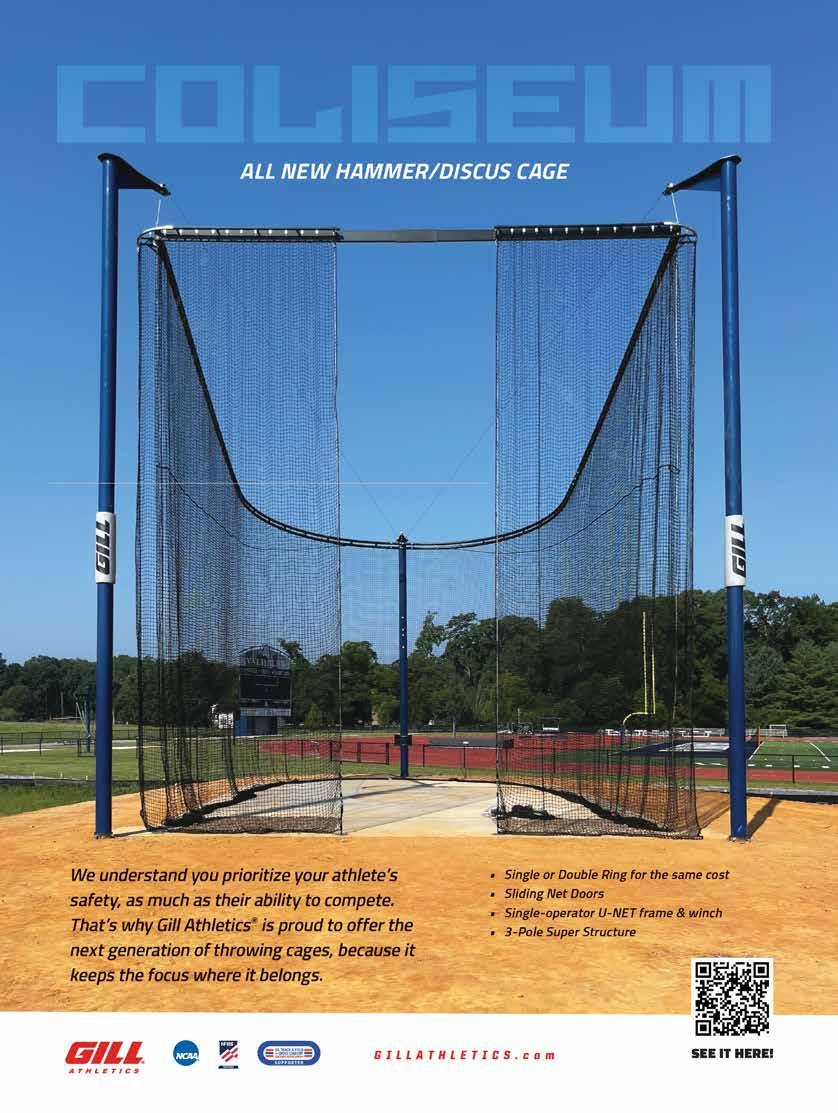
definition will entail all those physiological demands, psychological demands and motor skills necessary to reach high competitive levels.
Each large-scale training cycle (macrocycle) is broken into two general time periods. These periods identify the athlete as either in a preparation period or a competitive period. The athlete is either “training to train” or “training to race.” There may be competitions conducted during the preparation period, but by design these are not the championship level races that are held during the competition period.
Each period is broken into time periods called phases. They are identified by the scope of the competitions within. Each period is thus made up of three relatively independent phases with the aim of preparing the endurance runner for increasing importance in competition.
• Preparatory Phase
• Pre-Competitive Phase
• Competition Phase
The phases are important for the coach to thoughtfully construct, as they are used to apply a chronology of time-specific endurance training principles.
Preparatory Phase: During this phase the emphasis is placed on laying a foundation for the subsequent development of competitive speeds. In the case of endurance running events, the development of long lasting aerobic strength is critical. Aerobic threshold improvement, lactate [anaerobic] threshold improvement, and VO2 max improvement all involve many structural changes. Also an improved cardiovascular and pulmonary system, increases in substrate storage and usage, and long lasting oxidative enzymatic changes occur during this time. These developments in most cases are chronic [long term], and take a long time to bring about sufficient or significant changes.
Pre-competitive Phase: For endurance training, it is imperative that these long-term aerobic changes continue to be the emphasis. The aim of this phase needs to also include acquiring the capacity to perform at race energy levels near those needed for the competitive season. This development entails an emphasis in VO2 max since most of the racing in track and field by endurance runners is tied in closely to running at speeds above or below this energy delivery level during racing season. It is also neces-
sary to begin to develop anaerobic endurance, efficiency and capacity during the precompetitive phase.
Competition Phase: For the endurance runner, this phase should emphasize all those adaptations needed to perform at full race capacity. Optimal development of the anaerobic system, relative to the needs of racing, is critical at this time. Proper volume and intensity relationships should be a major concern. Peaking for the important competitions is the main focus of this phase.
It should be noted here that in an annual plan, the second macrocycle should contain the main competitions of the year. For endurance running events, this is primarily because of the prevailing theory that endurance runners can reach and maintain only one aerobic peak a year (Bompa 1983).
The concept of a large training cycle, whether it is the annual plan or a macrocycle is an important principle that must be understood. It is critical to have biological continuity, or a single direction, in the development of physiological parameters in the phase, the mesocycle and the microcycle.
A microcycle cannot be an independent unit in the training process. The theory of the large cycle will ensure the necessary conditions for a long-term adaptation of the endurance runner’s physiology ability to handle specific, intensive, maximal performances.
MESOCYCLES AND MICROCYCLES
Phases are broken into thematic mesocycles, each of which contain three to six microcycles. Each mesocycle is unique in that they each pursue a different training objective depending on where they fit into the training phase. Mesocycles are important to construct into a periodized training plan because their significance lies in their objective to develop relatively permanent changes in performance capacities. Once the thematic objective of the mesocycle has been met by the athlete, the mesocycle ends and another one begins.
Each mesocycle is divided into a series of microcycles. A typical microcycle is one week long, though it may vary from three to 21 days. Microcycles have four features (Dietrich 1982):
The structure (relative volume of the intensity) of the load demand changes during the cycle.
The load degree differs from one training session to the next, alternating between lower and higher loads according to the ath-
lete’s load tolerance and ability to recover.
The training sessions have different main tasks that use either special or general training exercises.
The training load rises for as long as is necessary to meet the objectives of the training phase.
A normal one-week microcycle will have two peak sessions (Freeman 1989). The most common microcycle involves six or seven days of training, with peak days followed by regeneration days (Figure 2). One of the peak days may or may not be a competition.
Advanced endurance runners may require a more sophisticated periodization model. Athletes with an older training edge, greater skills, and greater motivation can generally handle stronger workloads. A microcycle may need to be altered to provide more intensity (Figure 3).
An important component in microcycle design is variety. It is the coach’s responsibility to have several different workouts that address the same training objective. It is also important to vary the timing of each component within the microcycle, on an individual athlete basis, in order to find the most effective workout sequence for each athlete.
TRAINING SESSIONS AND UNITS
Once again, the components of the periodized training plan have been narrowed in the following manner:
• Annual plan
• Macrocycle
• Period
• Phase
• Mesocycle
• Macrocycle
• Session
• Unit
The session and unit components divide the microcycle and training days so that the training corresponds with what scientists know about the physical performance components: strength, speed, flexibility, coordination and endurance.
A unit is a specific element of a workout session that trains a specific physical performance characteristic. A session is a combination of four to six units that are combined to reach an objective for that session.
When explaining the session to the athlete there should be four stages presented for effective implementation:
The introduction: this is when the goals of
30 techniques MAY 2024 PLANNING FOR SUCCESS
KIRBY LEE IMAGE OF SPORT




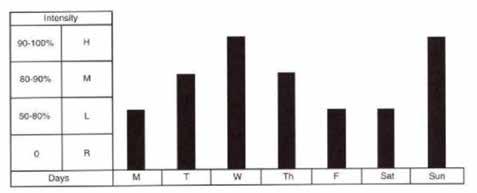
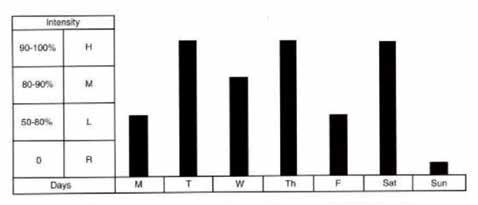
the session are explained.
The preparation: this is when the athlete does the warm up that is required for the session.
The core: this is when the main objective of the day’s session is achieved. The units must be administered in the proper developmental order and with the desired load.
The conclusion: this is when the proper cool down is done and an explanation of the take-home points are completed.
Linking training units into the proper physical performance component order in a session is a key to success. Depending on the focus of the session, ordering and linking units is done by considering the unit neuromuscular demand, the unit metabolic demand, the unit technical demand and commonality, the unit duration within the session, and the rhythm of the unit within the session to keep it interesting for the athlete.
A general model for unit ordering and linking physical performance components
within a session is shown as the following:
• The Preparation
• The Technical Unit
• The Speed Unit
• The Strength Unit
• The Endurance Unit
• The Conclusion
Technique and tactics are practiced first because they require a rested body. (Freeman 1989) When developing maximum speed, the speed training unit should be done first, immediately after the warm up. (Bompa 1983)
THE IMPORTANCE OF PERIODIZED ENDURANCE TRAINING
The usefulness of applying periodized training principles is important in the planning of the large cycles needed for success in the endurance running events.
Noted sport physiologist, Tudor Bompa states: “As a complex human endeavor, training effectiveness depends on one’s sci-
entific knowledge, professional expertise, methodical inference, and planning skills. By employing adequate scientific training guidelines, planning can become a primary tool utilized by the coach in his/her endeavor to conduct a well-organized training program.” (Bompa 1983)
“A coach’s training efficiency could be facilitated by employing a variety of plans, from short term, such as a training session plan, to long term, like a four year Olympic plan.” (Bompa, 1983)
REFERENCES
Bompa, T. 1983. Theory and Methodology of Training: The Key to Athletic Performance. Kendall/Hunt Publishing Inc, Dubuque, Iowa, USA. Pp. 131-179.
Bourne, D. 2008. A history of training theory and methods for elite runners through 1975. University of Texas Publishing, Austin, Texas, USA Pp 378-389.
Bowerman, W. 1975. Coaching Track and Field. Simon Publishing, New York, New York, USA Pp. 23-25.
Freeman, W. 1989. Peak When it Counts: Periodization for American Track and Field. Tafnews Press, Los Altos, California, USA. Pp. 45-90.
34 techniques MAY 2024 KIRBY LEE IMAGE OF SPORT
PLANNING FOR SUCCESS
FIGURE 2. TWO PEAK MICROCYCLES WITH A RACE ON THE WEEKEND (FREEMAN 1989).
RETIRED MISSISSIPPI STATE COACH AL SCHMIDT AND STILLWATER HIGH SCHOOL (MN) COACH SCOTT CHRISTENSEN CONTRIBUTED TO THE DEVELOPMENT OF THE ENDURANCE SPECIALIST CERTIFICATION COURSE CURRICULUM AND AS SUCH, THE CONTENTS OF THIS EXCERPT.
FIGURE 3. AN ADVANCED MICROCYCLE SHOWING GREATER INTENSITY (FREEMAN 1989).


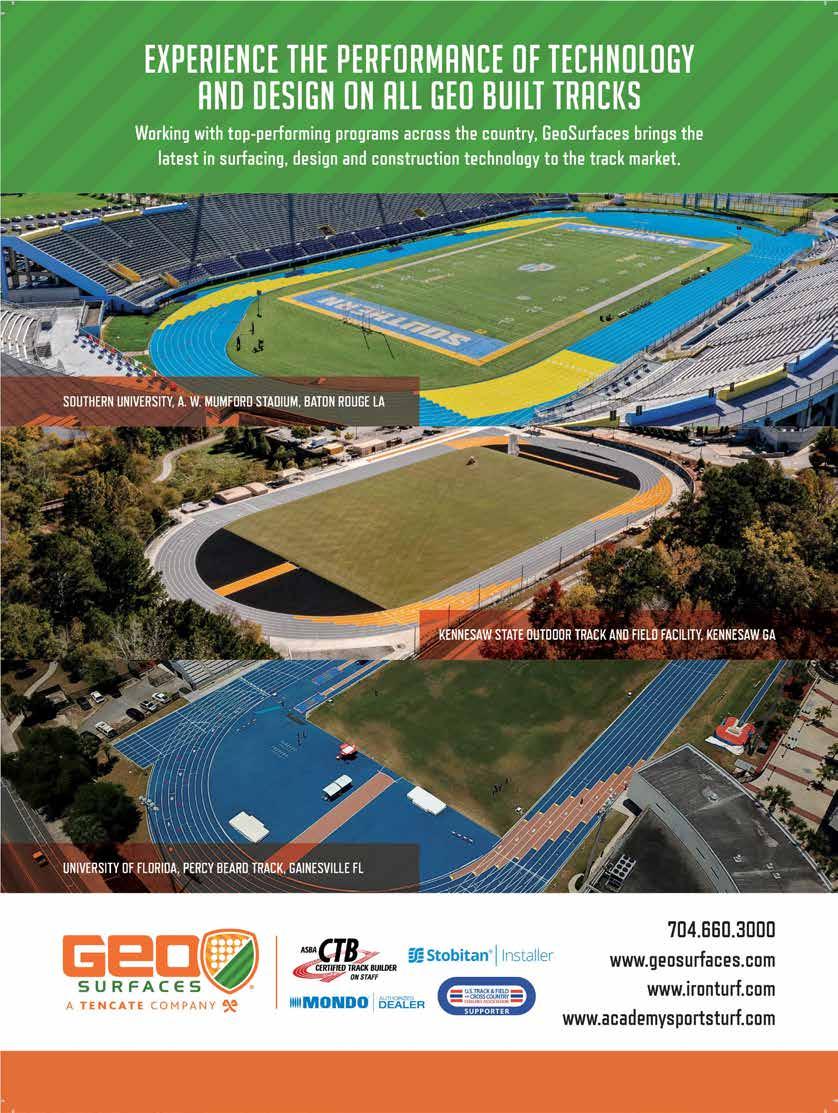



Roadmap to Rewards
The triple jump step phase repair flowchart
The second (step) phase of the triple jump has been a source of frustration for generations of jump coaches. Many coaches have sought advice on improving this phase, and I have been personally asked this question hundreds of times. So many coaches are looking for the simple answer or the magic drill.
In spite of the fact that this problem has dogged jumps coaches for ages, I have never seen an article or heard a clinic presentation that was based solely on the topic of fixing the step phase. I think the reason this topic has been avoided is, to be simple, it’s complicated.
The step phase is a point of collection for all triple jump problems. It effectively serves the same purpose as the “Check Engine” light on your car, signaling need for a deep, dark and mysterious search
through unpleasant countryside for problems. There are probably at least 20 triple jump faults that result in destroyed step phases. Take an athlete who makes two or three mistakes, and you are looking for the proverbial needle in the haystack when repairing technique.
Combine these issues with the fact that executing the step phase requires the ability to produce huge forces in a fraction of a second. Asking athletes who are not sufficiently trained to do this is a practice doomed to failure, even if technical coaching is sound.
The chart provided is designed to work as a roadmap on this search. It provides the coach a system of analysis and diagnosis for step phase problems by beginning at the step phase takeoff and working back in true cause-and-effect methodology. The chart
uses a flowchart approach to this diagnostic procedure, requiring certain evaluations to be made and video checkpoints to be analyzed as the roots of these problems are unearthed.
This chart might serve as little more than a poor flashlight on this diagnostic journey, but perhaps it can play a small role in the coaching of this event. Great coaches have many such charts in their heads whether they realize it or not. Therefore, more importantly, perhaps it can serve a much larger role by demonstrating the need for and effectiveness of systematic, logic based coaching and diagnosis in all track and field events.
MAY 2024 techniques 39
BOO SCHEXNAYDER SACSPEED.COM
KIRBY LEE IMAGE OF SPORT
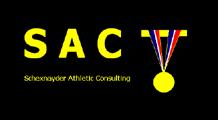
Insufficient Distance Never Happens
Cause: Excessive frontside mechanics in the Transion Phase excessive preparaon andor premature arm acon are liely
Cue hips up deemphasize nee li possibly cue bacside mechanics on taeoff leg side. Repair arm acons and lessen preparaon if necessary
Evaluate Pelvic Alignment Just Before Taeoff Foot Grounds
Flat lower bac indicates neutral posion curved lower bac indicates forward lt
Pelvis Neutral Pelvis Tilted Forward
Cause: Premature jumping
Cue paence on board allow rotaon of the shin in support forward push off of the board (as opposed to pulling)
Cause: Premature Jumping compounded by scing out the foot at taeoff.
Cue Exaggerated bacside mechanics at Taeoff and during Hop Phase Forward push off of the board (as opposed to pulling)
Cause: Forward lt of the pelvis in the transion phase
Liely Causes:
Acute shin angles in Transion Phase—Cue vercal pushing in Transion Phase
Faulty drive phase—Cue pushing pelvis up with each step and stress compleon of this process.
Cause: Loss of Step Phase swing leg mechanics at Cue iniaon of the swing the hop phase taeoff with a low recovery deemphasize the Step Phase
Cause: Improper limb leg cycle is too passive.
Cue passiveness and reflexive leg during the Hop Phase.
Cause: at taeoff
Cue forward Deemphasize
40 techniques MAY 2024 Evaluate Frontside 4”-6” should be present Excessive Distance Correct Distance
Alignment Just Before Flat lower bac indicates neutral posion curved l Pelvis Neutral
Frontside Distance
Foot Grounding 2”-4” should be present between hips and heel at impact Excessive Distance Correct Distance
Evaluate Pelvic
Evaluate
at Taeoff
Excessive Distance Correct Distance
Evaluate Frontside Distance in Transion Phase Feet should contact under the hips
Pelvis Tilted Forward
Never Happens
Phase posture due to poor at taeoff
swing leg movement during taeoff in an extended posion deemphasize nee li in
Evaluate Pelvic Alignment Just Before Hop Phase Landing
Flat lower bac indicates neutral posion curved lower bac indicates forward lt
Pelvis Neutral
Cause: Insufficient frontside at hop landing caused by insufficient elasc response development in the hip flexors at taeoff
Cue displacement and exaggerated bacside at taeoff complete release of hip flexor muscles at taeoff passive hop leg recovery in extreme cases cue increased push andor split off the board
exchange paerns in the Hop Phase hop cycle is too acve and the free passive. reflexive recovery of hop leg and acve extension and cycling of the free Phase.
Pelvis Tilted Forward
Administer the Knee Alignment Test
When nees cross in the hop phase they should be directly under the torso. Pass Fail
Evaluate Pelvic Alignment Just Before Taeoff Foot Grounds
Flat lower bac indicates neutral posion curved lower bac indicates forward lt
Pelvis
Cause: Poor free leg movement at taeoff. failing to counter forward rotaon of the pelvis naturally produced taeoff
forward push of the thigh eeping the front surface of the thigh vercal as long as possible also split. Deemphasize nee li or nee drive at taeoff.
Repairs fail or insufficient?
Start
Distance at Hop Phase Landing present between hips and heel at impact Distance Insufficient Distance or any Toefirst Landing
Frontside
Hop Phase Landing
ower bac indicates forward lt
Tilted Forward Pelvis Neutral



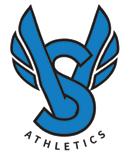






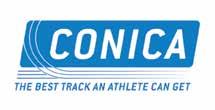




44 techniques MAY 2024 gillporter.com ucsspirit.com conica.com sportsbyapt.com/sport/track USTFCCCA Supporters mondoworldwide.com geosurfaces.com mfathletic.com vsathletics.com ucsspirit.com encoreintl.com plubbertrack.com athletic.net
Through their ongoing support of the U.S. Track & Field and Cross Country Coaches Association, these companies demonstrate their strong commitment to the sports of Track & Field and Cross Country. The USTFCCCA strongly encourages each member to purchase products and services from these supporters.












MAY 2024 techniques 45
garmin.com beynonsports.com getonform.com balfour.com connect.marines.com ontrackandfield.com
boosttreadmills.com
coachesdirectory.com maxmedals.com relaybatons.com lightspeedlift.com smartracks.run
2024 National Indoor Track & Field Athletes
NCAA DIVISION I

Chris Johnson Arkansas Women’s COY

Wes Kittley Texas Tech Men’s COY
NCAA DIVISION II

Damon Martin Adams State Women’s COY

Kyle Rutledge Pittsburg State Men’s COY
NCAA DIVISION III

Matt Jones Loras Women’s COY

Josh Buchholtz UW-La Crosse Men’s COY

Boogie Johnson Arkansas Women’s Assistant COY

Zach Glavash Texas Tech Men’s Assistant COY

Parker Valby Florida Women’s Track AOY

Nico Young Northern Arizona Men’s Track AOY

Rachel Glenn Arkansas Women’s Field AOY

Leo Neugebauer Texas Men’s Field AOY






Chris Parno Minnesota State Women’s Assistant COY
Jason Crow Pittsburg State Men’s Assistant COY

Gordon Reiter Washington (Mo.) Women’s Assistant COY

Nathan Petesch UW-La Crosse Men’s Assistant COY
Denisha Cartwright Minnesota State Women’s Track AOY
Miguel Coca Adams State Men’s Track AOY
Brynn King Roberts Wesleyan Women’s Field AOY

Kenadee Wayt Mount Union Women’s Track AOY

Sam Blaskowski UW-La Crosse Men’s Track AOY

Grace Alley Loras Women’s Field AOY
Cale Kassen Lee (Tenn.) Men’s Field AOY

Joseph White Carthage Men’s Field AOY
46 techniques MAY 2024
Athletes and Coaches of the Year

Doug Edgar Indiana Tech
Women’s COY

Bradley Sowder Cumberlands (Ky.) Men’s COY

Zontavius Johnson Olivet Nazarene (Ill.)
Women’s Assistant COY

Nate Wolf Dordt (Iowa) Men’s Assistant COY

Lisa Voyles Indiana Tech Women’s Track AOY

Luca Santorum Cumberlands (Ky.)
Men’s Track AOY

Machaeda Linton
William Carey (Miss.)
Women’s Field AOY

David Burnett
Iowa Western CC Women’s COY


David Schenek Barton (Kan.) CC Women’s COY
Brent Ewing Indian Hills (Iowa) CC Men’s COY

Wade DeVries
Iowa Western CC
Women’s Assistant COY

Tabarie Henry New Mexico JC
Men’s Assistant COY


Sanae Hasnaoui Barton (Kan.) CC
Women’s Track AOY

JaQuavious Harris
Salt Lake (Utah) CC
Men’s Track AOY

Robert Atwater Midland (Neb.)
Men’s Field AOY
Treneese Hamilton Barton (Kan.) CC
Women’s Field AOY

Olegs
Kozjakovs Vincennes (Ind.)
Men’s Field AOY
2024 NATIONAL HIGH SCHOOL CROSS COUNTRY COACHES OF THE YEAR

Chuck Schwartz Air Academy (Colo.) Girl’s COY

Timo Mostert American Fork (Utah) Boy’s COY
MAY 2024 techniques 47
NAIA NJCAA


